PinotFile: 7.17 May 7, 2009
|
Life is Good for Pinot LoversIn the eight years I have been composing the PinotFile I have never written an issue with such glee and conviction. The California and Oregon Pinot Noirs you will read about in the following pages are astonishingly good, and as a group, I have never tasted so many stellar wines. Winemakers have put to rest the “heartbreak grape” moniker that Josh Jensen popularized over twenty-five years ago and the derogatory title bestowed on the fickle grape, “a woeful beast,” by Burgundian Roger Capitain. Andre Tchelistcheff, who some have called America’s greatest winemaker, would have thoroughly enjoyed the latest brood of North American Pinot Noirs. Tchelistcheff passed away at the ripe age of 92 years, fifteen years ago. Known as the “Wine Doctor,” Tchelistcheff was a proponent of low alcohol, restrained oak, freshness and acidity in wines and would have balked at some of the styles of Pinot Noir made today. Despite this, he would have been proud of the fact that today’s growers and winemakers are making Pinot Noir from the heart. I never had the pleasure of meeting Tchelistcheff and regrettably have not tasted his 1946 Beaulieu Pinot Noir, a benchmark wine for Pinot Noir from California, but I feel like the legacy of that wine lingers on in the breeding of today’s wines. Tchelistcheff was more a romanticist than a technician and his emphasis on the aesthetics of winemaking remains a lesson that today’s best winemakers often take to heart. In 1994, Robert Balzer, an esteemed wine writer for the Los Angeles Times, related a story shortly after Tchelistcheff’s death that demonstrates this point. Tchelistcheff told Balzer, “I could not find the French Burgundy taste or perfume in the wines made in the cellar (at Beaulieu) before I came here.” When asked about Pinot Noir in California, Tchelistcheff said, “Young man, as the sun sets, go into the garden of Madame de Latour and pick one of her fine red roses, just as it has begun to open. Take it home. Put it into a vase....without water. Next morning, put your nose into the heart of that dying rose. Inhale the unique perfume. There you will have the scent to guide you to a perfect Pinot Noir.”
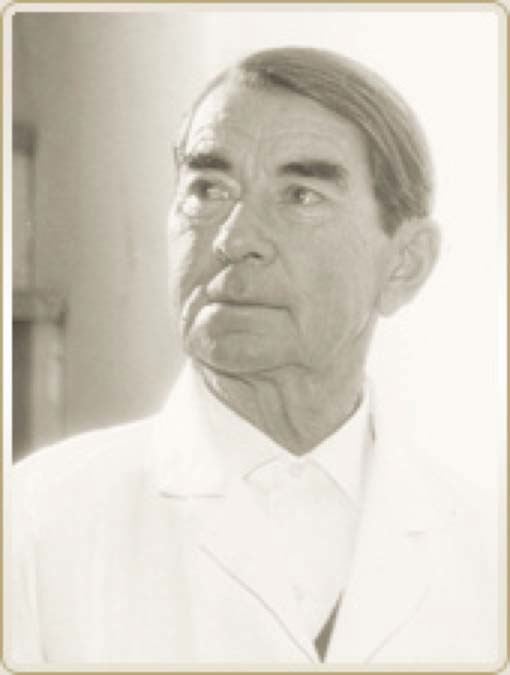 Sit down in a comfortable chair, pour yourself a glass of Pinot and ogle over some marvelous wines. Its good for your heart and healthy for your psyche. Great Pinot Noir is a valuable aspect of the well-lived life.
Papapietro Perry Pinot NoirWilliams Selyem has spawned more of today’s most notable Pinot Noir producers in the Russian River Valley than any other winery. The two principals behind Papapietro Perry are Ben Papapietro and Bruce Perry, both of whom were inspired to craft wine by the co-founder of Williams Selyem, Burt Williams. The trio met while they were all coworkers for the San Francisco Newspaper Agency, publisher of the San Francisco Examiner and Chronicle. As their friendship evolved, they all discovered they shared grandfathers who had made wine that was served nightly on the dinner table. In the 1970s, Ben lent Burt a hand in producing wine in Burt’s garage in Sonoma County. By 1980, Ben began making his own garagiste wines, including Pinot Noir, and Bruce joined him a few years later. Friends and family soon warmed to the wines and the two launched Papapietro Perry Winery in 1998 with their first commercial release of 75 cases. Early on, the winery’s biggest challenge was obtaining high quality Pinot Noir grapes. As their reputation grew and they began winning Gold Medals at major wine competitions, they enlisted a number of exceptional vineyard sources. They now have long term contracts in place with both Peters Vineyard and Leras Family Vineyard, both located in the Russian River Valley. Other Pinot Noir vineyards now include Charles Vineyard in the Anderson Valley and the Elsbree Vineyard in the Russian River Valley. Excellent Zinfandels, crafted in a Pinot Noir style, are sourced from the Elsbree Vineyard and Pauline’s Vineyard in the Dry Creek Valley. Papapietro Perry wines were initially crafted by Ben and Bruce at Rutz Cellars and then Balverne Winery. In 2005, they moved their winery and tasting room to its present location at 4791 Dry Creek Road, just a 10 minute drive north of downtown Healdsburg. The winery is truly a family operation with Ben’s spouse, Yolanda, and Bruce’s spouse, Renae, actively involved in the sales and marketing side of the business. The four of them have created a very warm and unpretentious atmosphere at their winery and Papapietro Perry was recently recognized by the San Francisco Chronicle as one of the top tasting rooms in Northern California. David Low (one of three winemakers at Anthill Farms who trained at Williams Selyem) shoulders most of the winemaking duties now with Ben and Bruce making major blending decisions. Production is 6,000 to 8,000 cases annually depending on the vintage. The clones are picked and vinified separately (except Elsbree Vineyard which is composed of a field blend), cold soaked for two to four days, fermented in 3/4-ton t-bins with two strains of commercial yeast (Burgundy and Assmannshausen), and aged 11 to 12 months exclusively in Francois Freres oak barrels. Appellation wines are aged in 1/3 new, 1/3one-year-old and 1/3 two-year-old barrels while vineyard-designate wines are raised in 50% new oak barrels (with selected lots receiving up to 100% new oak treatment). Papapietro Perry recently won the Pinot Cup at the 4th annual Pigs and Pinot Celebration at Charlie Palmer’s Dry Creek Kitchen in Healdsburg on March 20, 2009. When I visited the “Pappy-P” tasting room recently, I shot the following photo of Ben (right) and Bruce (left) proudly displaying their pig trophy from this event. At
 Pigs and Pinot, 50 of the world’s top Pinot Noir producers were evaluated by a renowned panel of judges. Some of the prestigious wineries in the competition were Anthill Farms, Benovia Winery, Brogan Cellars, Buena Vista, Craggy Range, De La Montanya (runner-up), Domaine Serene, Hanzell Vineyards, Kosta Browne, Lynmar, Merry Edwards, Paul Hobbs, Rochioli, Siduri, Talley Vineyards, Vincent Girardin, Willakenzie Estate, Williams Selyem and Zepaltas. I tasted through the lineup of 2007 Papapietro Perry Pinot Noirs both at the tasting room and the next day in my usual tasting environment at home. The wines sampled at home had been opened the day before at the tasting room and re-corked, then traveled over 400 miles in my car and still tasted stellar. I was very impressed with all the wines. They all featured moderate color, beautiful harmony and a panoply of luscious red fruits. The two appellation Pinot Noirs and the Leras Family Vineyard Pinot Noir are ready for drinking now, but the others will benefit from more bottle age. Some of the wines have been released to Wine Club members, while the Leras Family Vineyard Pinot Noir has been released to distribution, and the remainder of the 2007 vintage wines will be available periodically this year. Magnums of some wines are available. I suggest you make a point of calling, or preferably visiting, and claim your prizes now. Just don’t attempt to rapidly say, “Papapietro Perry Pinot Noir,” after consuming a glass or two of Pinot unless you love ridicule.
2007 Papapietro Perry Russian River Valley Pinot Noir 14.5% alc., 1,211 cases, $45. · The nose is highly nuanced with bright Bing cherry, cardamon, white pepper, herbs, musk and a hint of oak. Tasty cherry and berry flavors with a sidecar of oak and underbrush. Admirable acidity, a velvety texture and a pleasing finish.
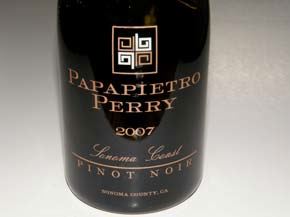 2007 Papapietro Perry Sonoma Coast Pinot Noir 14.5% alc., 715 cases, $45. · Deeper colored than the Russian River Valley bottling. Aromas of slightly confected cherries and strawberries with hints of herbs, spice and mocha. Reasonably concentrated flavors of dark red cherries complimented by brown spice and a touch of earthiness. Nicely composed with minimal tannins making it thoroughly enjoyable now. Like Drew Barrymore, very successful at a young age.
2007 Papapietro Perry Charles Vineyard Anderson Valley Pinot Noir 14.5% alc., 740 cases, $49. · This wine isn’t ready to drink. The nose is quite austere, displaying reluctant aromas of red fruits and herbs. A bit awkward and closed, there is a luscious berry core lurking in the background but it is drowned out by healthy dry tannins and a citrus tang that carries the finish. Definite potential here, but currently zippered up.
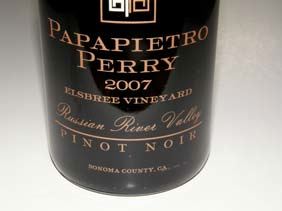 2007 Papapietro Perry Elsbree Vineyard Russian River Valley Pinot Noir 14.5% alc., 937 cases, $49. This vineyard consists of a field blend of about 20 clones on multiple rootstocks. Farmed by Chuck Elsbree. · A very complex and alluring nose displaying red plum and red current fruit with a sniff of cactus flower, roasted nuts, herbs and oak vanillin. A demure wine that is packed with flavors of spiced stone fruits and berries. Youthful tannins are evident and there is good grip, even a slight tartness to the refreshing and lingering finish. Still not showing all of its charms. I really like this wine and salute its uniqueness.
2007 Papapietro Perry Leras Family Vineyard Russian River Valley Pinot Noir 14.5% alc., 1,235 cases, $49. This vineyard is located centrally in the Russian River Valley, one road east of River Road behind Martinelli Winery. Several clones including Pommard, Beringer and Dijon 115, 667, 777 and 828. · This wine smells of the forest with oak and floral highlights. Juicy strawberry, cranberry and cherry fruit flavors. Herbs, oak and toast are evident but subtle. The fruit is pulled into line by a spark of acidity. Hi-toned, elegant and very satisfying.
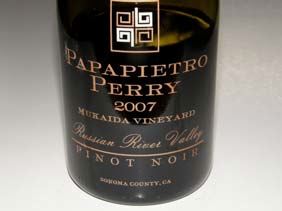 2007 Papapietro Perry Peters Vineyard Russian River Valley Pinot Noir 14.5% alc., 963 cases, $49. The Peters Vineyard is owned and farmed by Tom Mukaida. He originally was an apple grower who switched to farming Pinot Noir and Chardonnay in the 1980s. He sold his grapes to Gallo for several years. Composed of Pommard and Dijon 777 clones. · This wine is a real showoff. Very bright cherry fruit, even sensual, with a spicy touch of oak in the background. Plush and mouth filling attack of raspberry and cherry fruit with added flavors of savory herbs and baking spices. Perfectly harmonious with lithe tannins, this beautiful wine seduces with its smoothness and silkiness. You will need a cold shower after drinking this one.
2007 Papapietro Perry 777 Clones Russian River Valley Pinot Noir 14.5% alc., 342 cases, $70. A unique wine composed of Dijon 777 clones from five different Russian River Valley vineyards. Debuted at this year’s World of Pinot Noir. A popular wine in Las Vegas. · The heady aromas of black cherries, oak toast and Provencal herbs draw you in. Good concentration of layered berries and rustic cherries with a touch of brown spice. A vein of acidity runs through creating a slight tartness and a grapefruit tang on the finish. A wine showing great promise for the dinner table.
2007 Papapietro Perry Pommard Clones Russian River Valley Pinot Noir 14.5% alc., 436 cases, $70. · Deep aromas of black cherries, brown spice, barnyard and herbs. Medium-weighted dark red cherry and berry flavors that pick up intensity with air time. A touch of cola adds interest. Supple tannins and bright acidity. A very tasty wine, but still a Lolita, and needs another 6 to 12 months of bottle age.
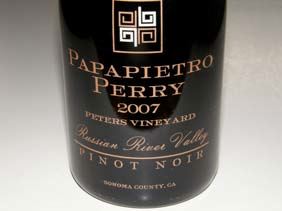 2007 Papapietro Perry Mukaida Vineyard Russian River Valley Pinot Noir 14.5% alc., 218 cases, $75. · Restrained but pleasing deep red fruit aromas and flavors that build in intensity in the glass. The fruit has a distinctive tropical bent. Impressively soft and smooth in the mouth. Oak is evident but not intrusive. I had the feeling that this wine might be the best in the lineup with another year in the bottle.
2006 Papapietro Perry Mukaida Vineyard Russian River Valley Pinot Noir 14.5% alc., $75. This label should have read, “Mukaida Block,” since the wine is an homage to Tom Mukaida and is sourced from his Peters Vineyard (he refuses to name the vineyard after himself). 8 best barrels aged in 80% to 100% new oak barrels. · Smoky oak and dark raspberry red fruit dominate the aromas and flavors. Smoothly textured with admirable balance. Picks up interest with time in the glass. Close to the 2007 vintage in character.
Papapietro Perry sells their wines through a mailing list, at the tasting room and via the winery’s Wine Club. There is some retail distribution of the larger production Pinot Noirs. The tasting room is open daily from 11:00 AM to 4:30 PM. 707-433-0422. The website is www.papapietro-perry.com. They stock some cool and suggestive swag including tee shirts for men that say, “LONG LASTING..with a big finish,” and for women that proclaim, “Full Bodied & Delicious, With Lots to Admire,” and “Papapietro Perry, So Good You’ll Want to Swallow.”

C. Donatiello
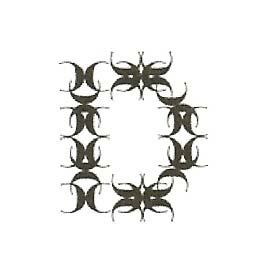 Christopher Donatiello, a former New York based wine and spirits distributor, has teamed with investment banker Bill Hambrecht to transform the site of the former Belvedere Winery on Westside Road in Healdsburg which was acquired by Bill Hambrecht in 1989. The winery has been completed updated with all the latest winemaking technology. The spectacular 14.5-acre estate has an organically farmed vineyard (Maddie’s Vineyard), a contemporary wood and glass hospitality center and tasting room designed by noted winery architect and landscaper, Ken Munson, and an organic garden that introduces visitors to flora that have a natural affinity with the aromas found in the Burgundian varietals produced at the winery. The C. Donatiello label was launched on June 21, 2008, and the winery has quickly become a welcome addition to the Westside Road family of famous wineries, a lineup some have anointed the “Rodeo Drive of Pinot Noir.” The focus of C. Donatiello Winery is small lot Pinot Noirs and Chardonnays from the organic estate vineyard and specially chosen vineyards in the Russian River Valley. Winemaker Webster Marquez developed his skills at Williams Selyem and Anthill Farms where he is partnered with two other winemakers. The entire operation is very classy with considerable thought given to a distinguished image and tasteful presentation of the wines. Premium quality is the goal here and the 2007 lineup of Pinot Noirs indicate that this precocious producer is a fast rising star in the Russian River Valley. I recently visited and sampled the 2007 C. Donatiello Pinot Noirs and re-tasted some of the wines later in my usual tasting environment at home. All three wines are benchmarks for Russian River Valley Pinot Noir in the 2007 vintage. I just can’t say enough good things about them! Web Marquez told me the fruit was “perfect” in 2007 and the wines are bright and fresh with good age ability and more finesse than the 2006 wines. There were no special problems in 2007 except reduced yields due to fruit set issues. July was very moderate for the Russian River Valley, which is critical for proper flavor development. The 2006 vintage Pinot Noirs are maturing earlier while the 2007 vintage Pinot Noirs are tight at this point and need decanting or time in the glass. The 2007 C. Donatiello Pinot Noirs were bottled in August, 2008. The 2007 Russian River Valley Pinot Noir needs more time and has not been released. The stylistic goal for the winery’s Pinot Noirs is layered, elegant wines. Most of the winery’s Chardonnays will be released in June 2009.
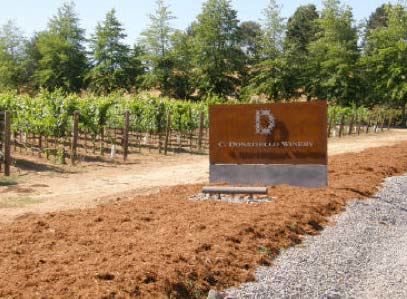
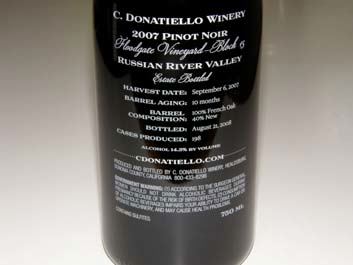 2007 C. Donatiello Floodgate Vineyard Block 15 Russian River Valley Pinot Noir 14.3% alc., 198 cases, $55. Clones 667 and 777 from the hillside block of this vineyard located in the northern Vine Hill area. · A marvelous nose composed of bright aromas of red cherries and berries, Provencal herbs, vitamins and a touch of oak. Plenty of body and weight with layered flavors of sweet dark cherries and raspberries exotically spiced and framed beautifully by supple tannins and restrained acidity. Built for the long haul with more body and spice than Tyra Banks on the Victoria Secret runway.
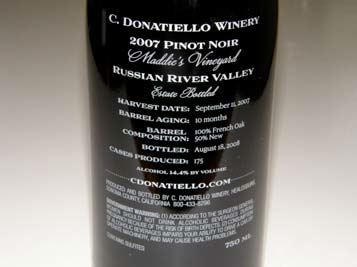 2007 C. Donatiello Maddie’s Vineyard Russian River Valley Pinot Noir 14.4% alc., 175 cases, $62. From the organically certified estate vineyard in front of the winery. Aged 10 months in 50% new French oak barrels. · This wine rewards the patient. A bit shy initially, the nose blossoms in time with intense berry jam aromas and a riff of oak. Very tasty spiced cherry and berry flavors pulled into focus by fine acidity and ripe tannins. Not as rich as the Floodgate Vineyard bottling, but very satisfying in its own right.
2007 C. Donatiello Hervey Vineyard Green Valley Pinot Noir 13.6% alc., 515 magnums, $142. Grapes from this vineyard were previously part of a blend for a large winery. This 9-10-acre vineyard in southwestern Sebastopol consists of 8-year-old vines planted to clones 115, 667 and 777 at a very cool site with plenty of fog. The result is an extra 3 to 4 weeks of hang time. Farmed by John Hervey, a Spanish teacher and dedicated winegrower. This wine comes from a block of 667 clone only. Aged 10 months in 100% 1-year-old French oak barrels. · This is one of those wines you keep coming back to. Bright and complex perfume of Bing cherries, fresh herbs, vanilla and soft oak. Stone fruit-driven rich middle palate that has plenty of structural power yet retains an appealing elegance. The finish is persistent like a dreamy three hour movie that never ends.
2006 C. Donatiello Russian River Valley Pinot Noir 14.2% alc., 2,750 cases, $48. A blend from the winery’s two estate vineyards. · A charming if delicate wine displaying aromas and flavors of red cherries and strawberries, herbs and spice with a soft and pleasing texture and a clean and vibrant finish.
C. Donatiello wines are available through a mailing list and at the comfortable tasting room (pictured below) at 4035 Westside Road, just minutes from downtown Healdsburg. Robert Conrad is the accommodating Director of Hospitality (707-431-4409). Private tours and extensive tastings are available by appointment. The website is www.cdonatiello.com.
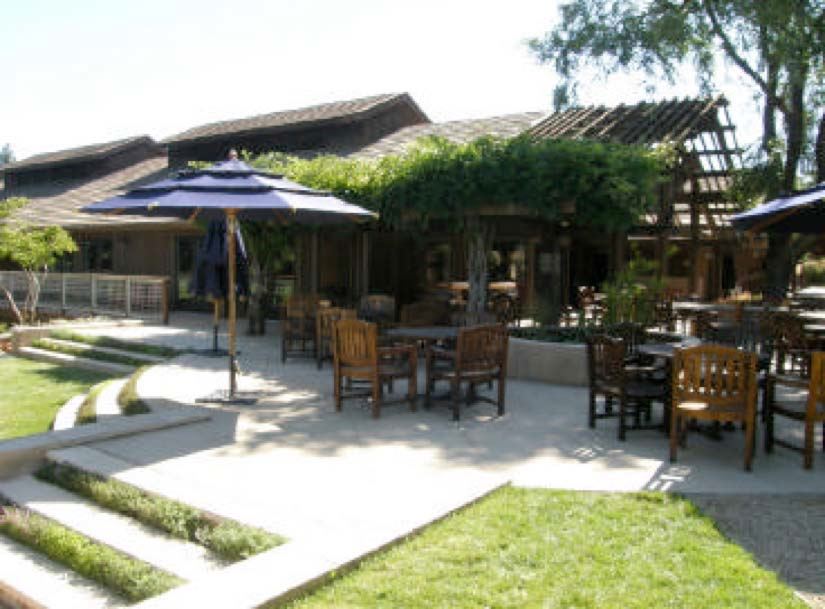
Mr. Pinot’s 30th VintageCalera Wine Company celebrated its 30th vintage with the release of its 2005 vintage wines. When Josh Jensen first planted his vines on a remote property in the Gavilan Mountains in 1975, he was among a few who were pioneering Pinot Noir wine growing in California. Dick Graff had preceded Jensen by ten years at Chalone, located just north of Calera in the same Gavilan Mountain Range in San Benito County. Others included Richard Sanford in Santa Barbara County, David Bruce and Merry Edwards, both in the Santa Cruz Mountains, Joseph Swan, Bob Pellegrini and Joe Rochioli, all in the Russian River Valley, Tony Husch in the Anderson Valley, and Francis Mahoney in Carneros. As it would turn out, despite the diversity of microclimates, all of them would prove successful. There was only one innovator other than Graff, however, who based his whole success on limestone which was rarely found in California soil in areas appropriate for viticulture. That was Josh Jensen. Jensen was a student of and fervent lover of Burgundy, and was convinced that it was the limestone in the soil in Burgundy that made the wines so special. Jensen has said, “Here in this country, the establishment doesn’t think limestone is important. I didn’t waste my time debating it. I just saw where the great Burgundies grow and decided to let my wines do the talking.” When Jensen released his first Pinot Noir in 1978, his was oblivious to the saga that would follow. He was completely focused on producing fine Pinot Noir in California and admittedly it was a big gamble. Jensen would say in later years, “In my case, I just gambled. Pinot Noir was immensely unfashionable when I started. I was young enough that I didn’t realize I couldn’t do it, so I just did it. I was too dumb to realize I couldn’t.”
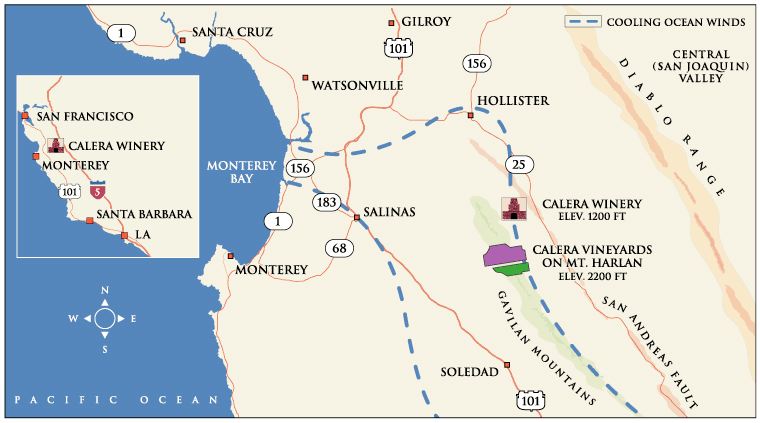 When Jensen returned from four years in Burgundy in 1973, he searched California for a site that combined limestone soils and a suitable climate for growing Pinot Noir. In 1974, he purchased 324 acres at 2,300 feet above sea level in the Gavilan Mountains for $18,500. The site had at one time been a limestone quarry. It was extremely isolated with no paved roads and Jensen did not own land that provided access to the property until 1982 when he bought adjacent land that became available. Most of the property consisted of steep hillsides and there was no electrical power or telephone lines. It was located on what the United States Geographical Survey termed “the central creeping zone” of the San Andreas Fault. This was about as unlikely a spot for growing Pinot Noir as one could find. What it did have, however, were soils with plentiful limestone and a perfect climate for Pinot Noir. The fog often rolls in from the neighboring valleys creating the potential for very long growing seasons and Calera often harvests well into October, after both Carneros and Sonoma County. Jensen chose the name Calera, which is Spanish for lime kiln, referencing the old lime kiln left on the land when he acquired it. In 1975, while living on the property with his family in a trailer, he cleared enough land to plant the initial three Pinot Noir vineyards, all at 2,200 feet: Jensen Vineyard was named after his father, Stephen, Selleck Vineyard was named in honor of Dr. George Selleck who first introduced Jensen to wine, and Reed Vineyard was named after Jensen’s business partner. Mills Vineyard, which was named after John Everett Mills who built the infrastructure on the property on Cienaga Road for the original mining operation, and the Chardonnay and Viognier plantings followed in 1984. The most recent planting in 1998 and 2001 is the Ryan Vineyard, named for Jim Ryan, the vineyard manager at Calera since its founding. There are also some unnamed plantings of Pinot Noir that have not yet produced commercially viable grapes. Jensen feels that there are locations on his property that may have even more potential for Pinot Noir than his original plantings.
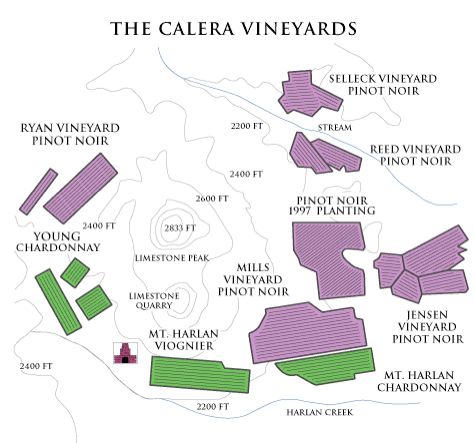 Jensen won’t say where the original clones of Pinot Noir came from that are planted at Calera. Selleck, Reed and two-thirds of Jensen are probably “suitcase clones” either originating directly from Domaine Romanee-Conti or indirectly from Chalone. The rest of the plantings are presumably nursery bench grafts sourced within California. The Mills Vineyard and the Chardonnay and second planting of Viognier are own rooted, the rest of the plantings are grafted onto nursery rootstock. By 2006, Jensen had 83.6 acres planted on his property consisting of nearly 1,100 acres. The winery, the world’s first and only completely gravity-flow facility, was built into a hillside on seven different levels. Calera is the only winery in the Mt. Harlan appellation (Jensen can also use the Central Coast AVA and the San Benito AVA designations as well). Curiously enough, the vineyards are located in the Mt. Harlan AVA, but the winery technically is not, so the Calera label cannot use the “estate bottled” designation. The first 30 vintages has brought Jensen many struggles. Yields have been consistently low, even less than a ton per acre in some vintages. He had to make Zinfandel from bought grapes until 1985 to provide some cash flow. Jensen constantly battled rattlesnakes, rabbits, gophers, deer, wild pigs and squirrels. He fought for recognition, and although by 1999 his wines had received considerable accolades from the wine press, the public seemed to turn their attention to newer and more fashionable cult Pinot Noir producers. Jensen was a firm advocate of the Burgundian idiom of Pinot Noir and lashed out at what he called “smasher-blasters,” California Pinot Noir fruit bombs that he said were “mostly one-dimensional, simple but potent drinks that merely lose their fruit, their main if not their only appeal, with the passing years and just turn into.....expensive mud.” For years, the Calera Pinot Noirs were shy and closed upon release, reaching their best drinking window between five and twenty years after the vintage. This may have been one of the reasons that the unsophisticated wine-drinking public was disenchanted with the wines. I have noted that recent vintages have been a little more approachable after release. The first winemaker at Calera was Steve Doerner, a microbiologist who had never made wine. He worked closely with Jensen until 1992, when he left for Cristom Estate in the Willamette Valley of Oregon. Subsequently, many future winemaker stars passed through Calera learning their trade from Mr. Pinot (Josh’s moniker). Calera’s winemaking regimen is as follows. The grapes since 1984 have not been de-stemmed except for some purchased
 grapes and grapes from young vines. No cold soak is employed. Typically, tartaric acid is added, native yeasts drive fermentation, punch downs are by hand two to three times a day, and the wines undergo 100% malolactic fermentation in Francois Freres barrels, typically 30% of which are new. Racking is done twice into the fining tank (egg whites are used) and bottling tank. The single-vineyard Pinot Noirs are aged for 16 months before bottling. The Central Coast wine is aged in 12-15% new barrels for 10 to 11 months. Jensen’s vision for the perfect Pinot Noir is one “that is perfectly balanced on the cusp of richness and complexity, of fruitiness and subtlety, and is neither one nor the other.” He describes the typicality of each of his single-vineyard Calera Pinot Noirs as follows.
Jensen Vineyard: 13.8 acres. Deliciously accessible aromas and flavors of blackberry, raspberry and strawberry jam. This vineyard produces wines of impeccable balance, rich, round and long-lived, sometimes developing with age to a thrilling combination of raspberry sauce richness, swished with the rasping perfume of leather. A complex wine and for me consistency of complexity is really the ultimate compliment to a Pinot Noir. Reed Vineyard: 4.4 acres. Aromas of exotic wild raspberries, cherries and chocolate combine with savory fumes and herbal notes of sassafras. Chocolaty, raisiny character most years. It has a creaminess and softness and a less dense style than Calera’s other single-vineyard Pinot Noirs. It is a precocious wine and the first of the single-vineyard wines to be released. Selleck Vineyard: 4.8 acres. My personal favorite almost every vintage. Usually the most complex and dense of the single-vineyard Pinot Noirs made by Calera. Magnificently perfumed, full of the classic Burgundian entangled mysteries of cherry and plum, wild raspberry and blackberry, toast and cinnamon spice. The flavors are deep with black fruits, spice and mint all present in these rich, full-bodied wines. It is also the fastest to evolve. It seems to have one more layer, one more bit of depth and complexity than the others, and since that’s what I appreciate the most, it appeals to me the most. This wine seems to have the greatest aging potential. Mills Vineyard: 15.4 acres. Fragrant, spicy, cedar-like aroma, with underlying cherry and red berry fruit. Flavors include plums, olives and bittersweet chocolate. Long finish and broad round tannins. Terrific structure but it often seems leaner than the other three. Compared to any other Pinot Noir from any other producer, it is rich, full-flavored, dark and complex. Compared to our own vineyards, it seems less rounded and supple and fat. Ryan Vineyard: 13.1 acres. Very bright and lovely, exhibiting bright red fruit, a hint of wild herbs, soft body and definitive Mt. Harlan minerality.
Recently I enjoyed sampling all the single-vineyard Calera Pinot Noirs from the 2005 or 30th vintage (Note: I previously reviewed the 2005 Ryan Vineyard so this issue features the 2006 Ryan Vineyard which is the current release). When you consider the pedigree, the impeccable winemaking, the uniqueness, the startling complexity and the age ability of these magnificent Pinot Noirs, the prices ($40-60) seem absurdly modest. These wines speak of terroir reflected in the distinctiveness of each of the vineyard-designate Pinot Noirs. I believe the Calera Pinot Noirs are among the greatest wines and most certainly among the most magnificent examples of their genre ever produced in California. I am not alone, for last year, Wine & Spirits Magazine named Calera Wine Company “Winery of the Year.” There are only a handful of California producers crafting wines like these.

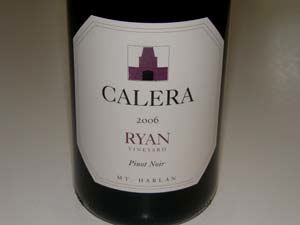 2006 Calera Ryan Vineyard Mt. Harlan Pinot Noir 14.5% alc., 2,155 cases, $40. Crop yield 3.29 tons per acre (average crop yield for this vineyard over last 10 years is 1.53 tons per acre). Average Brix 25.1º at harvest. Native fermentation. Aged 16 months in 30% new French oak. Unfiltered. · Potent and seductive aromas of black cherries, black raspberries, spice, white pepper and red hots. Luscious black cherry core which is a bit earthy and kissed by minerals. Plenty of good tannin for the long haul. Rich and mouth filling, persistent, with lively acidity. Perfect in every way. I’m buying a case.
2005 Calera 30th Anniversary Vintage Mills Vineyard Mt. Harlan Pinot Noir 14.0% alc., 1,351 cases, $40. Average 10 year crop yield from this vineyard is 1.3 tons per acre. Aged 16 months in 18% new French oak. Unfiltered. · Fabulous intoxicating perfume of strawberry and raspberry jam. I could only shake my head after sticking my nose into this one. Unbelievable! The concentrated flavors echo the aromas. Plenty of vibrant Pinot fruit finds every cranny in the mouth and is pulled into line perfectly by adeptly proportioned t n‘ a. Hey bro, you won’t find a wine like this from Dijon clones.
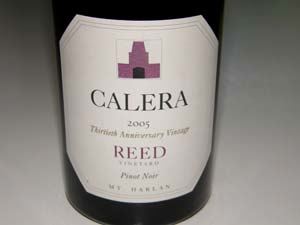 2005 Calera 30th Anniversary Vintage Reed Vineyard Mt. Harlan Pinot Noir 14.0% alc., 436 cases, $45. Average 10 year yield 1.48 tons per acre. Aged 16 months in 18% new French oak. Unfiltered. · Intense perfume of dark red plums and cherries with a thin oak cloak. Relatively light compared to the other Calera vineyard-designates and more approachable. Moderately demure red fruits touched by baking spice, cola and oak. Very supply tannins and bright acidic spine. A lovely debutante.
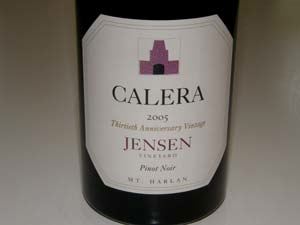 2005 Calera 30th Anniversary Vintage Jensen Vineyard Mt. Harlan Pinot Noir 14.0% alc., 1,264 cases, $60. Average 10 year yield from this vineyard is 1.51 tons per acre. This vintage 1.4 tons per acre. Average Brix at harvest 24.2º. Aged 16 months in 18% new French oak. Unfiltered. · A haunting aromatic profile that is highly nuanced featuring plum, blueberry, black cherry, oak and forest floor. Not as thick or chewy as the Ryan at this stage, showing more silkiness and brightness. Moderate tannins and a refreshing riff of citrus on the dry finish portend a long life ahead. A connoisseur’s Pinot.
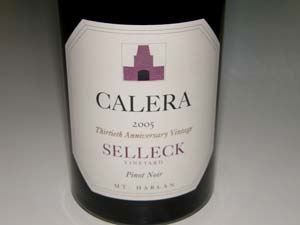 2005 Calera 30th Anniversary Vintage Selleck Vineyard Mt. Harlan Pinot Noir 15.0% alc., 287 cases, $63. Average 10 year crop yield 1.35 tons per acre. Yield in 2005 was 1.19 tons per acre. Aged 16 months in 18% new French oak. Unfiltered. · Stick your nose in this one and you won’t leave the bright cherry, fresh herb and brioche aromas. Healthy spiced cherry core that is rich and full without being jammy. Very soft and smoothly textured with moderate fine-grain tannins and an endless finish. The alcohol is perfectly integrated. Can you make a California Pinot Noir that is balanced at 15% alcohol? Check this wine out for your answer. This wine was still strutting its stuff the next day from a previously opened re-corked bottle. A showoff.
Calera Wine Company is located at 11130 Cienaga Road, Hollister. Tasting is available daily from 11:00 to 4:30. Directions are on the website at www.calerawine.com. 831--637-9170. Jensen’s newsletters are very entertaining but I haven’t seen one since 2007. The wines, including a number of library releases, are available on the website. In addition, there is wide retail distribution. Besides the single-vineyard Pinot Noirs, Calera produces a Mt. Harlan Cuvée Pinot Noir and a Central Coast Pinot Noir from bought grapes. Chardonnay and Viognier round out the lineup. All the single-vineyard Pinot Noirs are released in the half bottle format allowing the consumer to enjoy the wines at a younger age while preserving their full bottles for future enjoyment. Calera also offers a half bottle sampler containing the four oldest single-vineyard Pinot Noirs plus the winery’s Chardonnay and Viognier so one can sample to plan buys of full-sized bottles. The wines above are still available thorough internet retailers (the 2005 Jensen and 2006 Ryan can be bought directly from Calera). Damn the recession, buy Calera! The back label of the Calera wines contains an astonishing amount of information that Pinot Geeks will savor.
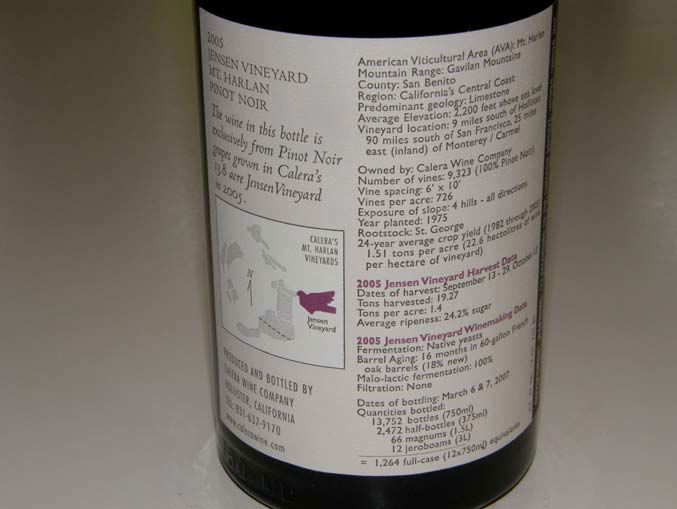
 For the remarkable complete story of Josh Jensen and Calera Wine Company, I would highly recommend the book, The Heartbreak Grape, A Journey in Search of the Perfect Pinot Noir, written by Marq de Villiers (McArthur & Company, paperback, $10.99).
Clos Pepe Vineyards: A Window Into Time and Place“Vigneron” Steve Pepe and vineyard manager and winemaker Wes Hagen are at the forefront of viticulture in the Santa Rita Hills. In less than ten years, the name Clos Pepe Vineyard on a bottle has become synonymous with quality. Think California Grand Cru quality. The Sta. Rita Hills appellation, nestled in an east-west valley, sits only a few miles inland from the Pacific Ocean. Morning fog, bright daytime sunshine and afternoon ocean breezes contribute to a terroir where Pinot Noir and Chardonnay can thrive. The resultant lengthy growing season slowly guides grapes to ripeness while allowing the fruit to retain the acidity that is so critical for a wine to perform at the dinner table and in the cellar. The sandy loam soils, rich in calcareous shale, contribute minerality and complexity to the finished wines. Pepe and Hagen have taken the right site and infused their knowledge, passion and commitment to create a vineyard that can produce wines of uncommon distinctiveness. In Hagen’s own words, he says, "We strive to produce wines that represent a time and a place. In a landscape where critics heap praise on 'heavy metal' wines more akin to fortified wine than a beverage for table, we believe that wine should integrate into a meal--we hope our customers discuss the flavors of wine and food and how they combine to make an experience. Great craft impresses not with an insistence that it be the sole focus of a room, but instead by its ability to integrate. I like to make wines that tell a story: a story of wind, fog, sunshine and the hard work of our crew. This vineyard has as much potential for Chardonnay and Pinot Noir as we are willing to imagine and draw from it with passion and labor. In this sense I want the wines to be 'jazz' over 'heavy metal'--a reflection of craft embedded in an ever-changing environment instead of a homogenized attempt to kowtow to the gods of concentration." You sense that Hagen is quite dedicated, cerebral and insightful and when you are trying to make premium Pinot Noir, these traits come in very handy. The name, Clos Pepe (“Clo Peppy”), comes from the French word “clos” and the vineyard proprietor’s name, Steve Pepe. In France, a clos may signify a walled vineyard or denote a winery in the same manner as the word “domaine” or “chateaux.” So Clos Pepe = Pepe’s Winery. Steve Pepe oversees the entire operation, freeing Wes Hagen to carefully hand-farm the vineyard which is planted to 24 acres of Pinot Noir (four clones) and 4 acres of Chardonnay (two clones). Hagen’s spouse, Chanda, assists him with the winemaking duties. A full-time vineyard crew of three insures that the vineyard is meticulously maintained. Farming is sustainable, organic and biodynamic. Yields are extremely low, averaging 1 to 2 tons per acre.
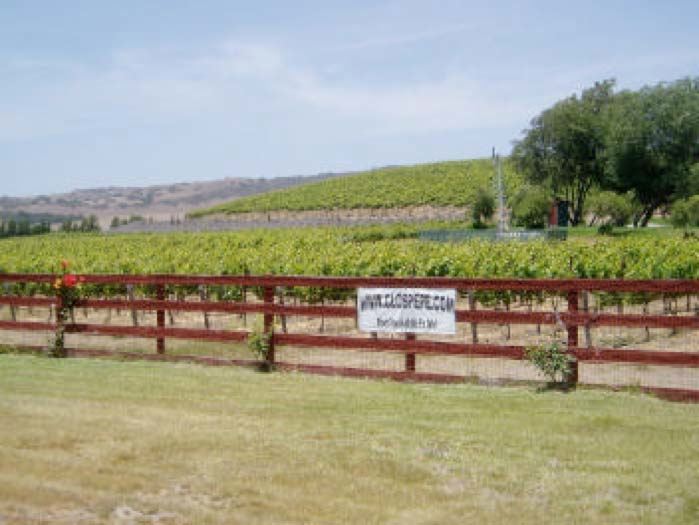 25% of the fruit from Clos Pepe Vineyard is retained for the Clos Pepe Estate wines which include a Pinot Noir, a Chablis-styled Chardonnay, a Rosé and a sparkling wine. The remainder of the fruit is distributed to some of California’s highest-profile wine producers including A.P. Vin, Brewer-Clifton, Copain, Ken Brown, Loring Wine Company, Ojai, Roessler and Siduri. A total of 800 cases of Clos Pepe Estate Pinot Noir and 100 cases of Clos Pepe Estate Chardonnay are produced. The first commercial Clos Pepe Estate wine was released in 2000. Winemaking is non-interventional and traditional for California. The grapes are fermented in small open-top fermenters, cold soaked for 2 to 3 days, allowed to begin fermentation with natural yeasts followed by inoculation with RC-212 yeast, aged in 25-50% new French oak barrels depending on the vintage, and bottled with minimal fining and little or no filtration. Hagen has really refined his style in recent vintages and the magnificent 2007 Pinot Noirs are easily drinkable now while possessing the structural power to age for 6 to 10 years.
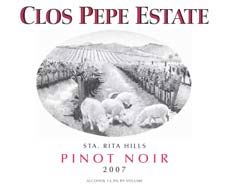 2007 Clos Pepe Estate Sta. Rita Hills Pinot Noir 13.9% alc., 650 cases, $54. · A marvelous drinking experience beginning with the clean and fruity nose hinting of spice and minerals followed by a delicious, sappy black raspberry and blackberry core that explodes in the mouth and saturates every taste bud. Ridiculous! Modest tannins, deft use of oak and perfectly harmonious.
 2007 Clos Pepe Estate “Vigneron’s Select” Sta. Rita Hills Pinot Noir 13.9% alc., 72 cases, $59. A blend of the favorite barrels in the cellar. · As good as the regular 2007 bottling is, this one raises the ante a notch. Really heady aromas of black cherries and raspberries with herbs adding interest in the background. Smooth and seamless pie-filling fruits on the palate, showing a perfect marriage of finesse and power. Plenty of fruit to thrill, beautifully framed by supple tannins and a lively vein of minerality and acidity, culminating in a long and scented finish.
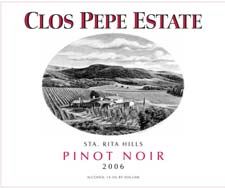 2006 Clos Pepe Estate Sta. Rita Hills Pinot Noir 14.5% alc., 700 cases, $56. · The fruit here is on the ripe side, with the wine displaying aromas of black currents and marzipan and flavors of macerated dark berries with a riff of dark chocolate and raisin. Beautifully composed, juicy, vibrant and alive with dusty tannins and a spark of acidity.
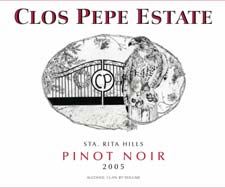 2005 Clos Pepe Estate Sta. Rita Hills Pinot Noir 14.3% alc., 650 cases, $56, sold out. · Dark reddish-purple color. Appealing mix of aromas of black cherries, herbs and a slip of oak. Loamy black cherry and blackberry coulis which is focused and polished. The tannins are suave, the texture is smooth and there is an edginess to the dry and lingering finish. Plenty of Pinot singing here. This wine reminded me of a 2005 Esmonin Hospices de Beaune Mazis Chambertin I drank the night before. The Clos Pepe was every bit as good.
Visit the excellent Clos Pepe Vineyards website at www.clospepe.com to view videos of the vineyard and extensive information about farming of the vineyard, winemaking philosophy, tasting notes and relevant insights about the artwork on the labels. Joining the mailing list is the best way to insure an allocation of the wines. An online store is available. Hagen contributes an informative blog about Clos Pepe on the website as well. Tours and tasting are available by appointment (consult the website). Customer service is professional and attentive. 805-735-2196
Valerie’s VineyardThis 1-acre vineyard is a partnership between long time Sonoma County public relations man Michael Coats, his wife Valerie, her parents and sister, and Chuck and Jerry Hanson who are owners of Hi-Time Cellars in Costa Mesa, California, a well-known wine retailer. All the partners share in the work of the vineyard which is organically farmed and overseen by viticulturist Phil Cotourri. The 1-acre vineyard was planted in 2000 by vineyardist Chuy Ordaz on resistant rootstock and a secret Russian River Valley clone. Yields are just under 2 tons per acre. The land sits less than 500 feet from the appellation line with Sonoma Valley and is in Sonoma Carneros. Previously the site was a plum orchard. The estate Pinot Noir was crafted by B.R. Cohn Winery’s winemaker, Tom Montgomery, at B.R. Cohn Winery, Glen Ellen. All three recent vintages have sold out.
 2006 Valerie’s Vineyard Carneros Pinot Noir 14.1% alc., 132 cases, $40, very heavy bottle. Aged in a mix of new and two-year-old French oak barrels for 17 months. · The nose offers the aromas of a fresh berry tart with a dusting of oak. Plenty of body and weight to the cherry and berries flavors which are framed by healthy tannins. The most striking feature of this wine is the velvety texture. Over time in the glass, the wine really grows on you as it reveals many nuances of flavor including cola and tea but it is the sensual mouthfeel that lures you back for another sip.
Shandel’s Oppenlander VineyardOppenlander Vineyard is located in Comptche in Mendocino County, just north of Anderson Valley. It is owned and farmed by fifth generation owners Bill and Norm Shandel. The property was homesteaded in the 1860s and Bill and his family still live in the original log home. The property was known as Oppenlander Ranch for nearly a century, then Shandel Ranch for over a decade, and now Surprise Valley Ranch, Inc. since 1963. The vineyard is located 8 miles as the crow flies from the Mendocino coast. Pommard and Dijon clones 114 and 115 are planted in Oppenlander (510) heavy clay loam which is unique to Comptche. The vineyard was first planted in 1997 and today there are 20 acres in vines. Winemaker John Pepe has been crafting superb and distinctive Pinot Noirs from this vineyard since the 2002 vintage and this low-profile label as been winning many awards in major wine competitions. This is not a beautifully landscaped and picturesque vineyard and the Shandel’s label is plain and simple. What is important here is what is in the bottle and that is great terroir-driven Pinot Noir. Phillips Hill Estates in Anderson Valley crafts an excellent version of Pinot Noir from this vineyard as well.
2007 Shandel’s Oppenlander Vineyard Comptche Mendocino County Pinot Noir 14.5% alc., >400 cases, $40, unreleased. · Moderately dark in color and darkly floral on the nose with full-bodied flavors of wild blackberries and raspberries, red plum and bittersweet chocolate. The taste is quite exotic and distinctive. The wine is nicely composed and charms with its satiny texture. The remarkably persistent finish leaves a hint of warmth in its wake. Still young and not as expressive as it will be, this one is a winner.
Shandel’s Oppenlander Vineyard Pinot Noirs can be ordered through the website at www.shandels.com. The 2006 vintage is the current release and is an excellent wine as well. A world-class blackberry jam is also available for sale.
Aubin Cellars “Verve”Aubin Cellars is a boutique producer of multiple varieties including Pinot Noir under the “Verve” label. The 2006 Pinot Noirs are sourced from the Russian River Valley, Sonoma Coast and Dundee Hills of Oregon. French-born owner Jérôme Aubin is an importer of oak barrels from Rousseau of Burgundy, St. Martin of Bordeaux, Allary of Cognac, A&K of Missouri and Balazs of Hungary. He also imports wine concrete tanks from Nomblot of Burgundy. The label was founded in 2001. The name “Verve” translates as “crafted with enthusiasm, vigor and integrity.” Verve is also a bilingual French-American noun reflecting Aubin Cellars’ bicultural background. The winemakers are Loren Tayerie (California bottlings) and Ray Walsh, formerly of King Estate and now with his own label, Capitello (Oregon bottlings). The wines have been consistently fine with attractive artwork on the labels and sensible prices. I have reviewed the wines a number of times very favorably. The two wines below are the best I have sampled from this producer to date. For the 2007 vintage, Pinot Noirs will be produced from Stoller Vineyard and Momtazi Vineyard in the Willamette Valley. Four California bottlings will include appellation wines from the Sonoma Coast, Russian River Valley, Monterey and Santa Cruz Mountains.
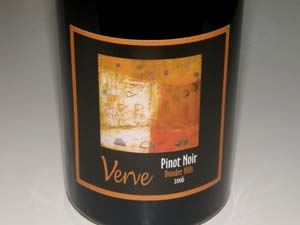 2006 Verve Dundee Hills Willamette Valley Pinot Noir 14.5% alc., 110 cases, $33 ($264 a case). Sourced from Stoller Vineyard. Label artist is Michelle Bonnetain of France. · The nose is quite pleasant featuring aromas of strawberries and red raspberries, a touch of good barnyard and a nice oak spin. Delicious darker red fruit and pomegranate flavors saturate the palate with a sidecar of oak and a touch of brown sugar. Juicy with refreshing acidity, gossamer tannins and a silky mouth feel. Very enjoyable.
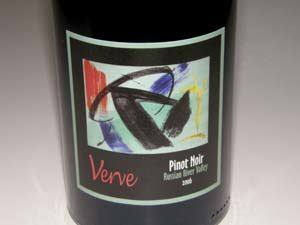 2006 Verve Russian River Valley Pinot Noir 14.6% alc., 425 cases, $33. Label art by Gerard Schnieder of France. Yields 2.2 tons per acre average. Clones are Pommard, 777, 828, Beringer and Cruz. Harvested at 27º Brix. 100% de-stemmed. Aged 17 months in 40% new French oak barrels. Unfined and unfiltered. · Bright effusive Bing cherry and strawberry aromas with a hint of cardamon spice and marzipan. Crisp and juicy dark red ripe cherry fruit with a little sassafras, root beer, raisin and spice accents. No rough edges, no discernible tannins. An easy drinking wine that is a bit on the ripe side but quite enjoyable.
Verve Pinot Noirs are available on the website at www.aubincellars.com. This is a producer with a bright future.
Kastania Vineyards: Pinot to Hoot OverHoot and Linda Smith lovingly maintain a beautiful property overlooking the eastern portion of the Petaluma Gap and the Petaluma River. Their 5-acre vineyard sits on a knoll welcoming northerly travelers on Highway 101 to southern Sonoma County wine country. The vineyard was planted in 1995 primarily to Pinot Noir and currently consists of three clones: 115, 667 and a Rochioli Vineyard selection. A small amount of Cabernet Sauvignon and Cabernet Franc are also successfully grown. For the first eight years, Kastania Vineyard supplied grapes for a vineyard-designate Pinot Noir made by Landmark Vineyards in Kenwood. Beginning with the 2005 vintage, the Smiths have kept the grapes for their own label named Kastania which translates as “chestnut” in Italian. Hoot said it just didn’t seem right to name the winery “Smith.” The winemaker is Leslie Cisneros who also crafts the wines at Arista in the Russian River Valley. Total production is 800-1,000 cases.
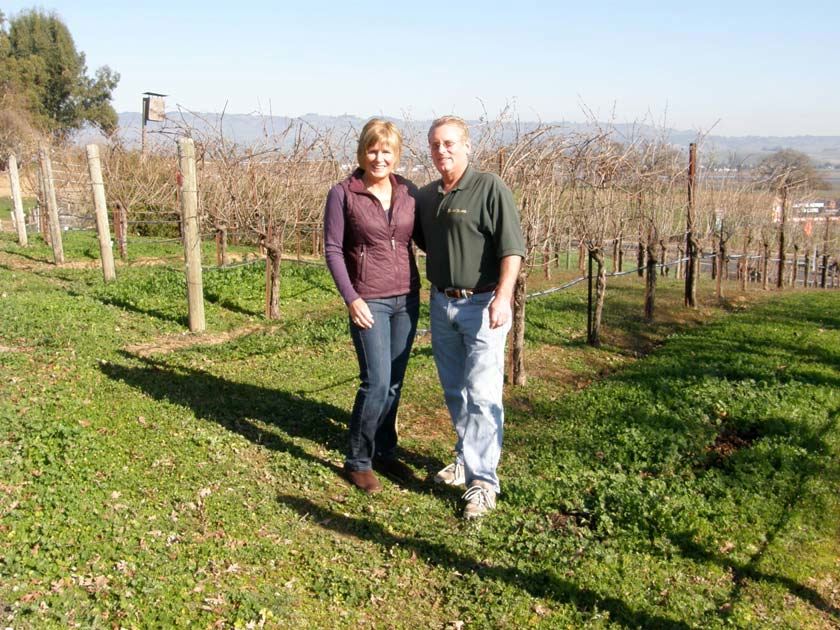 A relatively new winery and tasting room sit at the top of the property. The inviting tasting room is decorated with owl-themed memorabilia that Linda has collected over the years. Linda collected owls a long time before she met her husband, and likes to joke that she “ended up marrying a “Hoot.” A pair of owl-themed door handles greet visitors to the tasting room and a golden owl is prominently displayed on the Kastania label.
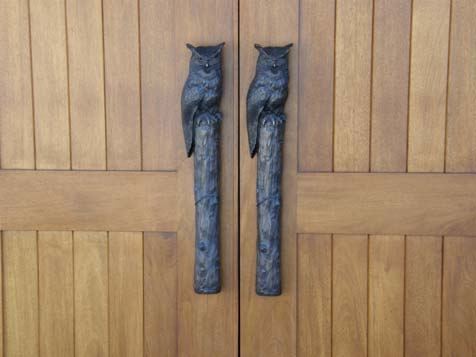 There are two Kastania Pinot Noirs for 2007: Jaden & Keira’s Cuvée (named after the Smith’s granddaughters) and a Proprietor’s Reserve. Both wines are impressive, reflecting deft winemaking and the complexity that can only come from established vines.
2007 Kastania Vineyards Jaden & Keira’s Cuvée Estate Grown Sonoma Coast Pinot Noir 14.6% alc., 400 cases, unreleased. Aged 11 months in 18% new French oak barrels. · Interesting array of aromas including cherries, strawberry, maple syrup, root beer, herbs and a touch of porto. The flavors echo the aromas with some added sassafras and oak. Supple tannins, smoothly textured and very light on its feet.
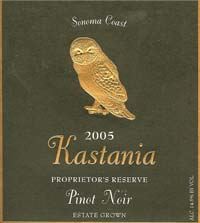 2007 Kastania Vineyards Proprietor’s Reserve Estate Grown Sonoma Coast Pinot Noir 14.6% alc., 336 cases, unreleased. Aged 11 months in 43% new French oak barrels. · This wine is a step up in intensity with deeper aromas of cherries, tea and oak toast and perfectly ripened fruit. Vigorous with flavor and character showing a rich core of spiced cherry fruit complimented by oak smoke. Saucy and fat, yet retaining an edge of finesse. A great mouthful of Pinot.
The excellent 2006 Kastania Pinot Noirs (Estate - $35 and Proprietor’s Reserve - $45) are still available from the website at www.kastaniavineyards.com. They were reviewed in Volume 6, Issue 58. Check with the winery for release date of the 2007 Pinot Noirs. The winery’s tasting room is open on weekends or by appointment (707-763-6348). The address is 4415 Kastania Road (entrance just south of the gas station). The Smith’s are wonderfully personable and you will enjoy a visit here immensely.
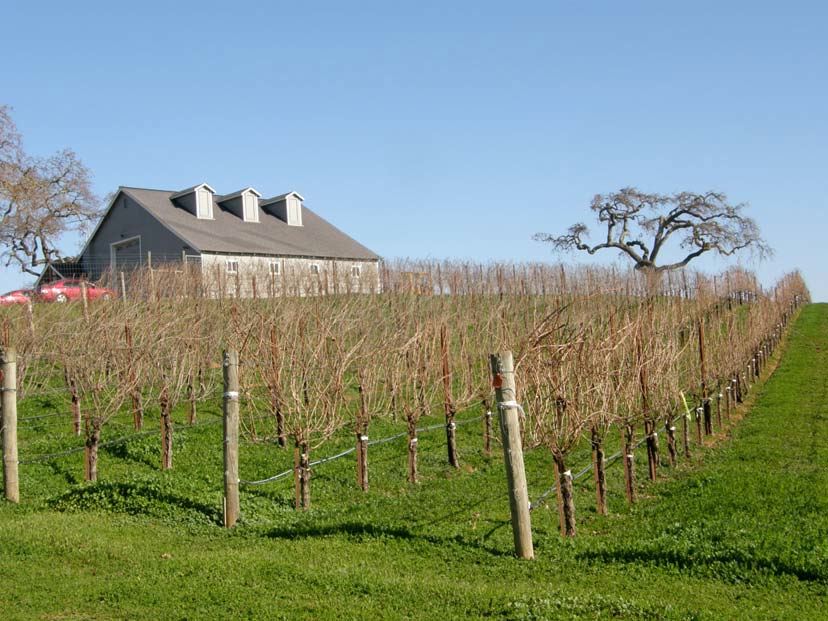
J. Lynne: Pinot Noir with a Soft Touch
 Jennifer (Jen) Lynne Wall is a talented winemaker who has accumulated a slew of medals for the Barefoot Cellars label since joining that winery in 1995. Barefoot still and sparkling wines are value-priced and directed at the millennial generation. The label’s tag line says, “Get Barefoot and have a good time!” Fans of Barefoot wines are called “barefooters,” and Barefoot Wine & Bubbly events are held nationwide. Owned by E. & J. Gallo Winery since 2005, Barefoot Wine Cellars produces over two million cases of ten different still varieties and four different sparkling wines. Lynne began college at University California Santa Cruz intending to study medicine but headed to Sonoma County after graduation and became hooked on becoming a vintner. She acquired her winemaking skills under the distinguished winemaker, Erin Green, now the winemaker at Pahlmeyer. Like many accomplished winemakers, Lynne yearned to have her own label. With the assistance and support of her husband, Mike, she debuted a Pinot Noir and Chardonnay in 2003 under the J. Lynne label and many accolades have followed. The current release, the 2007 J. Lynne Russian River Valley Pinot Noir, won a Gold Medal at the prestigious 2009 Sonoma Grand Harvest Awards. The wine was sourced equally from two vineyards: Cameron Ranch and Saralee’s Vineyard, both in the Russian River Valley. The clones are Martinelli and Dijon 777. The wine was 100% de-stemmed, cold soaked for several days, and partly whole berry fermented in tank with proprietary yeast. The wine was matured for 8 months in French oak barrels.
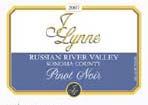 2007 J. Lynne Russian River Valley Sonoma County Pinot Noir 14.5% alc., 973 cases, $25. · Vivid perfume of cherries, strawberries and Asian spices. Refined and compelling flavors of fresh picked cherries, raspberries and strawberries with a hint of cola. Moderately light in weight with suave tannins, lively acidity and admirable elegance. A welcoming wine that is easy to drink and notable for its pinotosity.
J. Lynne Pinot Noir is available online at www.jlynnewines.com and is distributed in retail stores in CA, WI, LA, NJ, MN and VA. In California, customers can ask a retailer to bring it in through the distributor, MEGAWINE.
Paul Lato Wines: So Much with So LittleOn my way back from the World of Pinot Noir in March, 2009, I stopped by Central Coast Wine Services in Santa Maria to visit Paul Lato and taste his 2008 Pinot Noirs out of barrel. Paul is a Polish-born professionally trained and educated sommelier. In 2002, he decided to follow his dream to make his own wine and arrived in California’s Central Coast. That first year he made six barrels of wine and developed his skills while being mentored by Jim Clendenen at Au Bon Climat and Bob Lindquist at Qupe. He has closely studied the winemaking of the late Henri Jayer of Burgundy, while his stateside admiration is reserved for the older style of Williams Selyem wines. He has tasted wines from those producers and carefully studied their approach reaching the conclusion that “true artisanal winemaking is based on intuition, sensitivity and passion.” It is astonishing to visit and see Paul’s working space - a 20’ by 30’ cage containing maybe 20 barrels of wine, a table that serves as a chemical lab, a small desk and a few boxes of bottled wine on a single pallet. It seems to fit Paul well, however, because he purposely intends to remain small. He is passionate about quality, often declassifying up to half of his production that fails to meet his high expectations. He has grown slowly and methodically, limited by his own resources (he spurns investors) and by his insistence on doing every step of the winemaking process himself. Chardonnay was added to the mix of Pinot Noir (80% of production) and Syrah in 2007. Total output varies depending on the vintage but does not exceed 500 cases.
 Paul only works with special vineyards that have a strong personality. Almost all contracts are per acre so he can work intimately with the vineyard managers to achieve his goals. Paul employs long cold soaks, quite warm fermentations, gravity racking only when necessary, and gentle fining with no filtration. He makes it clear that he has no recipe, varying his punch downs, new oak regimen and aging period (generally 14 to 18 months) depending on the vintage on the vineyard source of the wine. His goal is the perfect balance between elegance and intensity. His wines have always been admirable for their purity and refinement, finesse and balance but also for their distinctive reflection of each vineyard’s terroir. My previous comments about Paul are poignant. “Paul Lato bleeds Pinot Noir. He is a rare individual of great passion who is humble, yet aristocratic, both humorous and charming, and with a smile that shows a zest for wine and the good life.” My tasting notes of the 2008 Paul Lato Pinot Noirs from barrel and the 2007 Paul Lato Pinot Noirs from bottle follow.
2008 Paul Lato "Lancelot" Pisoni Vineyard Santa Lucia Highlands Pinot Noir 15.1% alc.. Sourced from the original plantings that are 20 years old. · Full-bodied, intensely fruited, with an appealing earthiness and hints of anise and tar. Despite its heft, the wine retains a lively acidity, moderated tannins and complete integration of the alcohol.
2008 Paul Lato “Duende” Gold Coast Vineyard Santa Maria Valley Pinot Noir Martini clone which performs well at this site. · A real charmer showing tasty strawberry and Asian spice flavors. A delicate minerality roams the background.
2008 Paul Lato “Sine Cera” Fiddlestix Vineyard Sta. Rita Hills Pinot Noir “Sine Cera” is a Latin idiom meaning “without wax.” Wax was used historically to cover imperfections in statues. One new barrel of clone 113. · Lovely aromas of dark cherries and berries with a touch of chocolate and violets. Smoothly textured with supple tannins and a soft and scented exit.
2008 Paul Lato “Suerte” Solomon Hills Vineyard Santa Maria Valley Pinot Noir From a block at the top of the vineyard planted to clones 115 and 667. Solomon Hills is the most westerly vineyard in the Santa Maria Valley and is clearly visible to travelers on Highway 101. “Suerte” means luck and Paul chose this name because he had suffered a string of accidents and survived without significant injury. This wine seemed to bring him luck. · Darker fruited, nicely spiced with plenty of structural power, noticeable oak, soft tannins and a tangy finish that lasts and lasts.
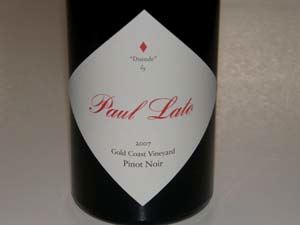 2007 Paul Lato “Duende” Gold Coast Vineyard Santa Maria Valley Pinot Noir 14.5% alc.,100 cases, $63. · Really lovely nose touting Bing cherries, forest floor, sandalwood and baking spices. Delicious midweighted cherry fruit with oak playing a supportive role in the background. Silky, vibrant and perfectly harmonious.
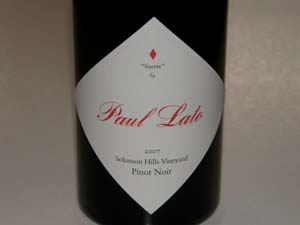 2007 Paul Lato “Suerte” Solomon Hills Vineyard Santa Maria Valley Pinot Noir 14.5% alc., 150 cases, $68. · Sensual perfume of fresh crushed raspberries and blackberries with the slightest hint of oak. Gorgeous fruit accented with musk and cola and framed harmoniously by soft tannins and a spark of acidity. Pinot my paramour.
 2007 Paul Lato “Sine Cera” Fiddlestix Vineyard Sta. Rita Hills Pinot Noir 14.7% alc.,125 cases, $73. · Deep, dark brooding nose showing aromas of black cherries, raspberries and white pepper. A distinctive wine with woodsy and earthy dark stone fruits that are both lush and mysterious. Deft touch of oak and admirable corralling of tannins. A hint of citrus shows up in the finish which is unbelievably persistent. This is a wine that comes at you, grabs hold and demands your attention. Screams for duck.
Paul Lato Wines are sold through a mailing list at www.paullatowines.com. There is very limited retail and restaurant distribution. Check www.vinquire.com for internet availability from several sources. Paul is not the best businessperson and a number of followers have not received offerings despite joining the mailing list. If you want the wines, and you do, either call Paul (805-260-3210) or visit him in Santa Maria (by appointment). Paul’s Chardonnay is outrageously good and I will report on this and other California Chardonnays in a future issue.
MacMurray Ranch: Pinot Noir with a HistoryThe MacMurray Ranch property dates back to the early 1850s when the land was first settled by Colonel Hugh Porter. He had returned from the Mexican War and chose a site for his home adjacent a bend of Porter Creek, a small river that empties into the larger Russian River. Porter’s family lived on the land for generations and successfully farmed crops on the rich soils. In 1941, Fred MacMurray, a legendary actor of Hollywood’s Golden Era, and his wife, June Harver, bought the ranch as a getaway from his home in Los Angeles. He became a gentleman rancher and frequently brought his wife and family to this picturesque setting in the Russian River Valley. MacMurray raised prize-winning cattle on the property and his children rode horseback through the hills. The family was an integral part of the local agricultural community. He nurtured the land for 50 years, acquiring open land when neighbors moved away. In 1996, the MacMurray family sold the ranch to the Gallo family. The original buildings were restored, trees were planted along Porter Creek, and vines were established behind the farmhouse with the first vintage of wine coinciding with the new millennium. The current vineyard layout is depicted in the map below.
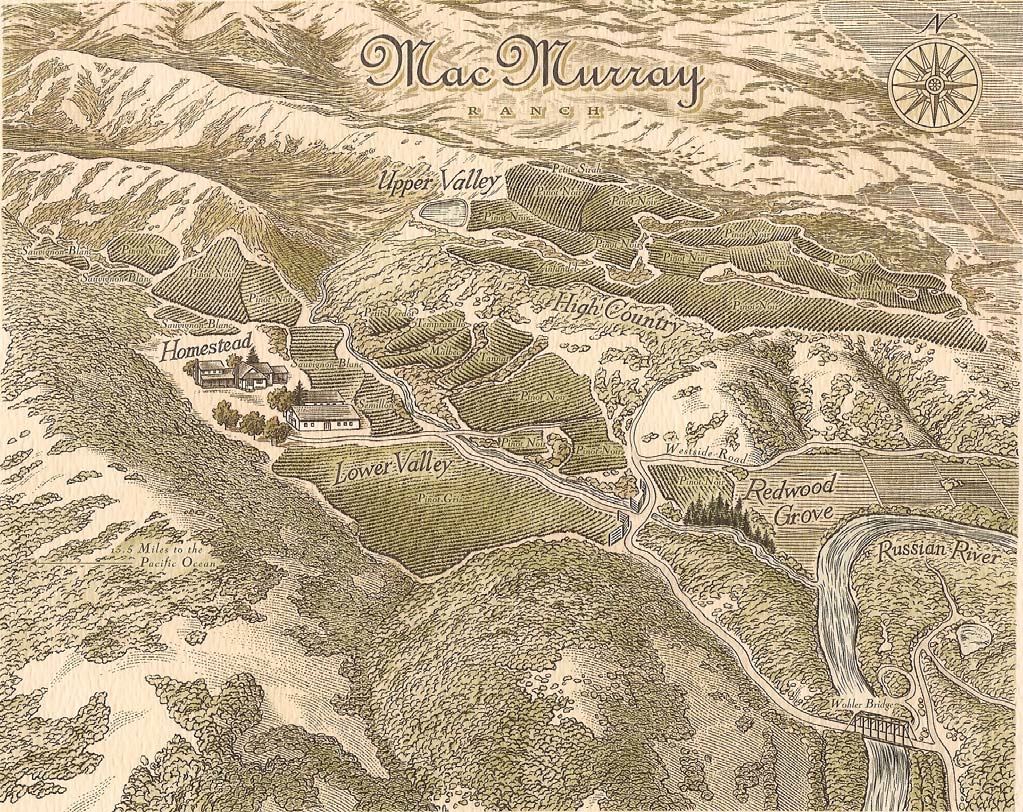 Kate MacMurray, who was one week old when her parents bought the ranch in 1941, still lives on the property, hosting Sonoma County community and wine events such as the Russian River Valley Winegrower’s “Grape to Glass.” She represents the heritage of the MacMurray Ranch and is the perfect spokesperson for the Ranch’s wines. The ranch encompasses more than 1,500 acres on both sides of the Russian River. Only about 450 acres are planted to wine grapes to preserve the land’s natural habitat. Plantings are predominantly Pinot Noir and Pinot Gris with small blocks of Sauvignon Blanc, Zinfandel and Syrah. Multiple clones of Pinot Noir, including Pommard, Dijon and Wädenswil are planted to match specific parts of the ranch land. Talented winemaker Susan Doyle is a native of Tasmania with a degree in Environmental Geography from University of Tasmania and a postgraduate diploma in Viticulture and Enology from Canterbury University in New Zealand. Susan’s task is unique for a winemaker in California, for she crafts Pinot Noir from multiple appellations, including the Central Coast, Sta. Rita Hills, Sonoma Coast and of course, the Russian River Valley. Oregon is in her future as well. She says, “In the Russian River Valley it’s all about black fruit and silky tannins and mouth feel. In the Sonoma Coast, it’s tighter, more structural with red fruits. In the Santa Rita Hills, it’s more layered and herbal and earthy. We’ve found another spot in the Central Coast where the Pinot has red cherry flavors along with the traditional earthy tea notes. It’s different in the character detail, but it’s all Pinot Noir at its core. And that’s exactly the point, isn’t it?
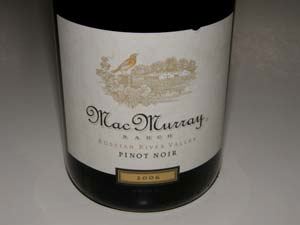 2006 MacMurray Ranch Russian River Valley Pinot Noir 14.0% alc., $35. Hand harvested, de-stemmed, cold soaked for 5 days, fermented with a mixture of natural and Burgundian yeasts. · This is a dense fruit-driven wine which lacks the trademark spice and cola features of many Russian River Valley Pinot Noirs. There is plenty of dark fruit and tannin but this wine could be from anywhere.
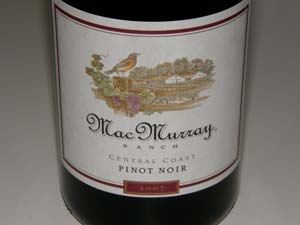 2007 MacMurray Ranch Central Coast Pinot Noir 13.5% alc., $24. Primarily sourced from Olson Ranch in the Santa Lucia Highlands. Harvested in the early morning, de-stemmed, cold soaked, fermented with a mixture of natural and proprietary Burgundian yeasts. · Pretty red tinged violet color. Shy, but appealing aromas of dark berries, wooded forest and oak spice. Rich melange of berry fruit and a hint of oak with gossamer tannins and bright acidity. A nice drink for the money.
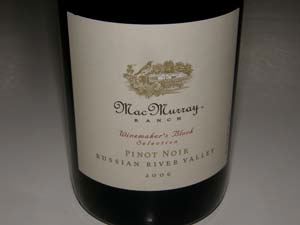 2006 MacMurray Ranch Winemaker’s Block Selection Russian River Valley Pinot Noir 14.5% alc., 400 cases, $60. Clones 828 and 37 (Mt. Eden). Hand sorted and de-stemmed into open top 1 to 3.5 ton fermenters with a target of 95% whole berries. Cold soaked for 5 to 7 days and inoculation with a mixture of natural and Burgundian yeasts. Pressed gently using a basket press. Aged in a combination of new and 1-year-old French oak barrels with an additional 6+ months in bottle before release. · Now we’re talking. Really attractive aromas of black cherry and cherry cola. Plush core of cherry and berry fruit with some spice, leather and graham. Long, stylish and silky with tannins reigned in and oak playing a subtle supportive role. Clearly more sophisticated, refined and elegant than the other MacMurray bottlings. This wine will match up with the any of the very best Pinot Noirs currently made in California. This Pinot was kissed by an angel.
Other E. & J. Gallo Pinot Noirs:
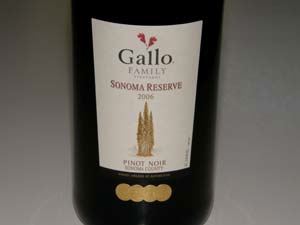 2006 Gallo Family Vineyards Sonoma Reserve Sonoma County Pinot Noir 13.5% alc., $18. De-stemmed, cold soaked with other details not disclosed. Gina Gallo is the winemaker and Matt Gallo is the winegrower. · Deep reddish-purple color. Highly nuanced nose displaying aromas of black fruits, forest floor, mushrooms, cola and toasty oak. Rich attack of black raspberry and blackberry fruit which is mouth filling and pleasing and builds in intensity in the glass. The tannins are soft and supple, the oak is deftly managed and a pleasing lift of citrus complements the finish. A good crossover wine for Merlot and Cabernet drinkers.
Andrew Frei bought land in the Russian River Valley and Dry Creek Valley in the 1890s. His sons and grandsons took over and named the business Frei Brothers. Today, Frei Brothers Reserve wines still use grapes from Andrew’s original properties. Jim Collins is the chief viticulturist now for Frei Brothers Reserve. Farming is sustainable and incorporates ideas from organics and biodynamics. A falconer is employed to prevent starlings from eating grapes at some of the vineyards.
 2006 Frei Brothers Reserve Russian River Valley Pinot Noir 13.5% alc., $30. Picked in the cool morning,de-stemmed, not crushed to retain whole berries, cold soaked for a few days, several yeast strains employed, aged in oak barrels for 24 months. 97% Pinot Noir. · Slightly confected nose of raspberries and black cherries with a modicum of oak. Copious, dark, well-oaked fruit that is a bit overwhelmed by flamboyant tannins most evident on the dry finish. This wine will perform best at the dinner table with some hearty short ribs.
ZD Wines: Honoring the FounderWhile most wine history buffs like to rhapsodize about the early days of Pinot Noir and its origins in the Central Coast (Chalone and Calera), the Russian River Valley (Joseph Swan and Rochioli), the Santa Cruz Mountains (Martin Ray, David Bruce)), and Santa Barbara County (Richard Sanford), ZD Wines has quietly been continuously producing Pinot Noir for 40 years. Two former aerospace engineers from Sacramento, Norman deLeuze and Gino Zepponi started ZD Wines in a small rented farm building in Carneros in 1968 with the dream of producing the classic Burgundian varietals, Pinot Noir and Chardonnay. The name “ZD” was short for “zero defects,” a reference to their aerospace engineering background. Their winery permit was the first to be issued in Sonoma County in nearly twenty years. Their first vintage in 1969 produced 300 cases of Pinot Noir from René di Rosa’s Winery Lake Vineyard in Carneros and a small amount of White Riesling. This Pinot Noir was historically significance because it was the first wine to have the Carneros designation on the label. A Chardonnay followed in 1971. The winery was a family run boutique operation initially with the partners and their families working on weekends and during vacations. In 1978, the partners acquired a 6-acre plot of land in the Rutherford district of Napa Valley on the Silverado Trail and 3 acres were planted to Cabernet Sauvignon. The next near a new winery was built on the site and deLeuze left his aerospace job to pursue the wine business full time. In 1993, the winery was enlarged and updated. Gino Zepponi died in an automobile accident in 1985, and the de Leuze family bought his shares in the winery. In 1996, ZD Wines bought a historic vineyard in Carneros and planted 7 acres to Pinot Noir. Christened the DeLeuze Vineyard, both Swan and Hanzell heritage selections were planted. The first vintage from this vineyard was 1999 and today grapes from this organically farmed vineyard make up the backbone of the ZD Reserve Pinot Noir. The de Leuze family, now with the third generation becoming involved in the business, continues to manage ZD Wines. Norman’s son Robert was the winemaker until 2001, when he handed the reigns to Chris Pisani who had worked at the winery for several years. Robert continues in the role of Winemaster and CEO. In April, 2009, ZD Wines released the 2007 Founder’s Reserve Pinot Noir, a tribute to the memory of Norman deLeuze, ZD’s founder who passed away in October, 2007 at the age of 75. He was an advocate of the non toxic treatment of diseases and had an ongoing relationship with the University California Davis Oncology Department. This spring, ZD Wines is donating $1 for every paid tasting in the tasting room to the DeLeuze Family University California Davis Endowment for a Non Toxic Cure for Lymphoma. The Founder’s Reserve Pinot Noir is packaged in a bottle displaying a vivid portrait of Norman deLeuze.
2007 ZD Wines Carneros Pinot Noir 13.5% alc., $40. · Heady aromas of black cherry liquor with a faint hint of oak and alcohol. Tasty earth-kissed black cherry and blackberry fruits which are accented by flavors of cola and herbed tea. Lighter-weighted and a tad dilute but offers an appealing soft texture and easy drinking.
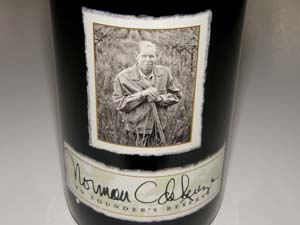 2007 ZD Wines Norman de Leuze ZD Founder’s Reserve Carneros Pinot Noir 13.9% alc., 750 cases, $65. Very cool label. The de Leuze family wanted to reproduce the original photograph from the book Napa-Behind the Bottle by author Bill Tucker. This special release honors Norman de Leuze's favorite varietal and also coincides with the winery's 40th anniversary. Sourced from an organically farmed Napa Carneros vineyard using deficit irrigation, crop thinning and hand canopy management. Aged 15 months in French oak barrels. · A vibrant and expressive nose brimming with aromas of black cherries, strawberries and raspberries in harmony with a subtle riff of herbs. Multifaceted flavors of cherries, raspberries, currants, sassafras, and game. Richer and darker than the regular bottling and packed with flavor, yet almost ephemeral in quality. The tannins are fine grained and the texture all silk and satin. Still drank beautifully the next day from a previously opened re-corked bottle. A very stylish wine displaying the hand of a talented winemaker.
ZD Wines is located at 8383 Silverado Trail in Napa Valley. The winery’s tasting room is open daily from 10:00 to 4:30. The wines are sold on the website at www.zdwines.com and through fine wine retail stores. Tours of the 30,000 case per year winery are available by appointment (707-433-1385).
Sonoma Coast Vineyards: West County Pinot NoirsJohn and Barbara Drady founded this label in 2002. John is a reserve-duty Gold Ridge Sonoma firefighter who assists with winemaking and directs the marketing of the Sonoma Coast Vineyards portfolio of wines. Barbara is well known in wine circles for her company, Affairs of the Vine, which conducts educational wine tastings for corporations and other groups, offers several weekend “Wine Boot Camps” where wine enthusiasts can obtain hands-on grape farming and winemaking experience, and directs the yearly “Pinot Noir Shootout and Summit.” The pair have used their experienced palates to develop a label that focuses on Pinot Noir, Chardonnay and Sauvignon Blanc from the extreme or “true” Sonoma Coast. The extreme Sonoma Coast is referred to as “West County,” and is roughly from Jenner in the South where the Russian River empties into the Pacific Ocean, to Annapolis in the North, and from the beaches to 5 to 6 miles inland including the first two ridges of the Coastal Range of mountains and the western slope of the third ridge. Ft. Ross, Occidental and western Sebastopol and Freestone are included, although all are south of Jenner. The Dradys are committed to producing ultra-premium wines that have age ability. The vineyards selected for Sonoma Coast Vineyards wines are situated within a 4 mile radius of Freestone and are complemented by vineyards in the far southwestern reaches of the Sonoma Coast. According to Barbara Drady, the following distinctions typify the true or extreme Sonoma Coast: (1) Long growing seasons, (2) Cool temperatures which are marginal for ripening, (3) Production limited by temperatures, (4) Vines that produce grapes with mature fruit at lower sugar levels, (5) Crop loads that are very small, and (6) Thin, rocky and shallow soils that have not been farmed previously. In 2008, Sonoma Coast Vineyards was sold to Leslie Rudd, who along with business partner Pat Roney, owns interests in a number of specialty food stores in Northern California including the Oakville Grocery and Dean & Deluca, a restaurant in Napa, and six wineries. He transformed Girard Winery into Rudd Winery, together with Roney bought Windsor Vineyards in 2007, acquired Grove Street Winery in Healdsburg in 2008, started a new label, Windsor Sonoma Winery, with a planned future production of 50,000 cases of Pinot Noir and Chardonnay, and has now entered the super-premium Pinot race. John and Barbara Drady remain intimately involved with Sonoma Coast Vineyards but the infusion of capital has allowed the label to expand production from 4,000 to 20,000 cases. The winemaker is Anthony Austin (pictured below), who this year enters his 35th vintage. A University California Davis graduate in enology, Austin studied under the great Andre Tchelistcheff. He directed the first crush at Firestone Winery in 1976. Firestone was the first modern day commercial winery in Santa Barbara County. In 1981, Austin left to establish his own label, Austin Cellars, in Los Olivos. He made two legendary Pinot Noirs in 1982 from the Sierra Madre Vineyard and the Bien Nacido Vineyard.
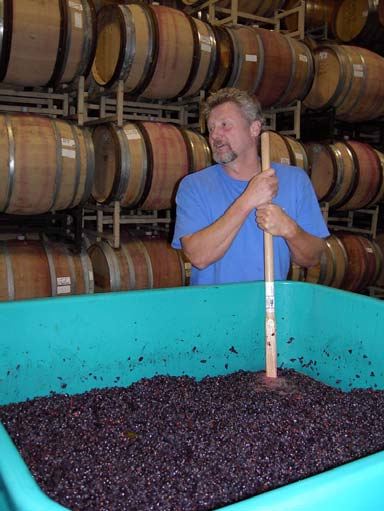 The Sonoma Coast Vineyards Pinot Noirs are Burgundian at heart in that they are made for food and are not a meal in themselves. None of them have aggressive tannins but do have the lively acidity that predicts age ability. The prices below are roughly what you can expect on the current secondary market.
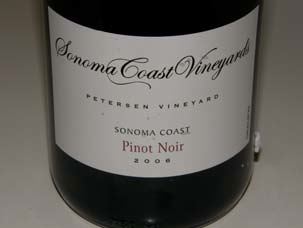 2006 Sonoma Coast Vineyards Petersen Vineyard Sonoma Coast Pinot Noir 13.9% alc., 380 cases, $63. Clones 115, 667. 10% whole clusters, 8-day cold soak, hand punch downs, wild and Assmanhausen yeast fermentation, aged 10 months in 50% new 3-year-old air-dried tight grain French oak barrels. Lightly filtered. · Enticing aromas of cherries and strawberries with hints of forest floor and oak char. Brimming with juicy flavors of cherries, cranberries and pomegranate with a vein of earthiness, oak and herbs running through to the finish. Silky with gossamer tannins. The most precocious wine in the Sonoma Coast Vineyards lineup that is ready for drinking now.
2005 Sonoma Coast Vineyards Sonoma Coast Pinot Noir 14.4% alc., 487 cases, $60. Clones 115, 667 and 777. 50% Koos Family Vineyard, 50% Zephyr Ranch Vineyard. 30% whole clusters, cold soaked 8-10 days, hand punch downs, spontaneous wild yeast fermentation supplemented with Assmanhausen yeast. Aged 20-22 months in 50% new French oak barrels. Lightly fined and filtered. · Moderately dark reddish-purple robe. On the nuanced nose there are aromas of black raspberry, forest floor, sage and oak toast. Darkly fruited with prominent plum jam flavors framed by seasoned oak. Admirable elegance and silkiness with brisk acidity showing a bit of citrus peel on the finish. Improves when tasted later in the day suggesting age ability. Wants, needs and should have food if drunk now.
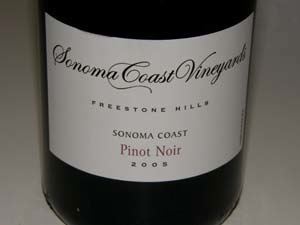 2005 Sonoma Coast Vineyards Freestone Hills Sonoma Coast Pinot Noir 14.2% alc., 270 cases, $62. Balistreri (4%) and Zephyr (96%) vineyards. Yields one-half to one ton per acre. 75% de-stemmed, 25% whole clusters, 8-10 day cold soak, hand punch downs, fermentation initiated with wild yeast and finished with Assmanhausen yeast. Aged 21 months in 50% new 3-year-old air-dried tight grain French oak barrels. Lightly fined and filtered. · Ripe berries and cherries create a glass-filling presence on the nose. High-collared ripe dark fruit with a riff of herbs and loam and a healthy acidic spine leaving an impression of grapefruit peel on an amazingly long finish. This wine has more cajones, the ripest fruit and the most comforting mouthfeel of any of the other 2005 vintage Pinot Noirs from Sonoma Coast Vineyards. Tasted again the next day from a previously opened re-corked bottle, it was even better portending a long life ahead.
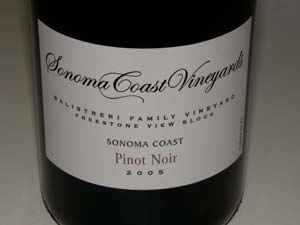 2005 Sonoma Coast Vineyards Balistreri Family Vineyard Freestone View Block Sonoma Coast Pinot Noir 13.9% alc., 72 cases, $67. Clones 114, 115, 667 and 828. 30% whole cluster, 11 day cold soak, hand punch downs two to three times a day, wild and proprietary yeast fermentation. Aged 21 months in 50% new 3-year-old air-dried, tight grain French oak barrels. Lightly fined and filtered. · Aromas of a fresh dark cherry pie entice. Demure dark stone fruits with plentiful oak and a vein of citrus that lingers on the finish. A bit austere and tight now but showing respectable finesse and soft tannins. This wine will perform beautifully at the dinner table.
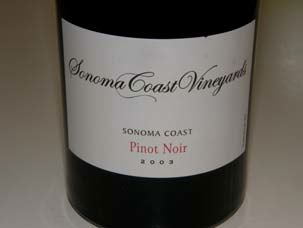 2003 Sonoma Coast Vineyards Sonoma Coast Pinot Noir 14.16% alc., 783 cases, $60. Clones 113, 114,115, 667, 777, Pommard 3, Swan from six vineyards. Aged 19 months in 50% new French oak barrels. · On the aged nose there are aromas of dark fruits with a hint of porto, forest floor and crusty bread. Very ripe fruit accented by cigar box, root beer and raisin. Very smooth and silky with a pleasing dry finish.
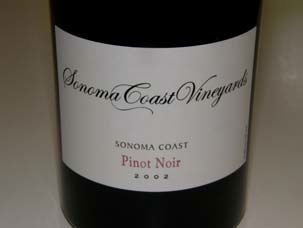 2002 Sonoma Coast Vineyards Sonoma Coast Pinot Noir 14.28% alc., 715 cases, $60. Clones 113, 114, 115, 667, 777, Beringer from four vineyards. Aged 19 months in 50% new French oak barrels. · Strange fruitless aromatics resembling ranch dressing. Grape flavors, a touch of raisin, leather and oak. Moderately light with a very silky texture and moderate fine-grained tannins.
The back labels are quite unique and informative:
 Sonoma Coast Vineyards Pinot Noirs are widely distributed through Wilson Daniels Ltd (St. Helena, CA, 707-963-9661) and are available from the website at www.sonomacoastvineyards.com. I have seen some of the wines significantly discounted from internet retailers. An excellent Chablis-styled Chardonnay is quite age able and a Sauvignon Blanc is among the best made in California. 707-836-5617. Contact me through my website and I can arrange a private tasting of Sonoma Coast Vineyard wines and a tour of their vineyards with John Drady.
Castalia Wines: A Little Known GemTerry Bering has been the Cellar Master at J. Rochioli Vineyards for nineteen years. Part of his pay is fruit from the estate, more specifically, prime fruit from a 19-year-old block of River Block and a hillside 18-year-old block planted to cuttings from the original West Block vines. Bering has been quietly crafting small amounts of a single Pinot Noir every year since 1992. The name, Castalia, refers to Apollo’s favorite spring on Mount Parnassus in ancient Greece that bestowed drinks of the spring gifts of poetry and inspiration. Since 2006, Bering has put Rochioli Vineyard on the label, the only Pinot Noir in California other than those from J. Rochioli Vineyards so designated. Last year’s 2006 vintage was stunning and the current 2007 release is equally spectacular. Considering the pedigree of the fruit, this little known gem is pretty much a no-brainer.
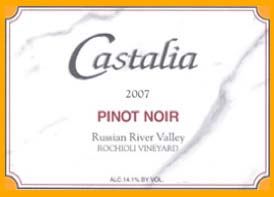 2007 Castalia Rochioli Vineyard Russian River Valley Pinot Noir 14.1% alc., 326 cases, $50. Aged 15 months in 30% new French oak barrels. · Effusive aromas of cherries, berries, mocha and minerals jump out of the glass. Delicious black cherry fruit which grabs your attention and lingers like a romantic kiss. Richly fruited and highly nuanced with hints of earth, tea, herbs and oak. The perfect harmony of optimally ripe fruit, vital acidity and refined tannins. The wine was opened in the morning and was even better later in the day. A dreamy wine of great charm.
2006 Castalia Rochioli Vineyard Russian River Valley Pinot Noir 14.1% alc., 328 cases, $50. · The nose is brimming with black cherry fruit accompanied by subtle dried herbs, smoke and char. Restrained but generous dark red fruits, especially black raspberry, coat the mouth and are complimented by stylish oak spice. The wine sports a refined mouth feel and the right touch of acidity. An engaging Pinot Noir of the highest quality and one that Apollo would have surely enjoyed.
Castalia Wines Pinot Noir is sold in 6 and 12 bottle lots on the website at www.castaliawines.com. There is limited retail and restaurant distribution.
Keefer Ranch: A Russian River Valley TreasureKeefer Ranch vineyard is located near the headwaters of Green Valley Creek in Sebastopol. Marcy Keefer, a nurse, and her husband, Robert Keefer, a doctor who is now deceased, bought the property, a former apple orchard, in 1985. Planting started in 1988 and now consists of 40 acres of Pinot Noir and 10 acres of Chardonnay. The Pinot Noir clones are a mixture of Dijon 114, 115, 777, Pommard 5, Mariafeld (23), Wädenswil (2A), Swan and Calera. Keefer Ranch is now farmed by Marcy Keefer and her son Craig Strehlow who is also the winemaker. Part of the Green Valley sub appellation of the Russian River Valley, Keefer Ranch vineyard is planted on Goldridge Loam which is particularly suited to Pinot Noir. The Green Valley is defined by fog and is usually the first area of fog intrusion through the Petaluma Gap and the last place the fog burns off, making it the coolest and foggiest part of the Russian River Valley. For many years, Keefer Ranch has supplied grapes to notable Pinot Noir specialists including most recently, A.P. Vin, Failla, Freeman, Kosta Browne, Loring Wine Co., Pali and Siduri. Beginning with the 2006 vintage, Marcy and Craig launched their own Keefer Ranch label. They source from a newer 1-acre block planted to a Swan selection as well as some Pommard clone from elsewhere in the vineyard. The inaugural Pinot Noir was impressive as is the latest release.
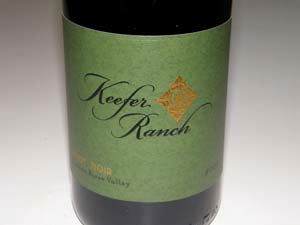 2007 Keefer Ranch Green Valley of Russian River Valley Pinot Noir 14.2% alc., 243 cases, pH 3.45, $42. 9 day cold soak, 11 day fermentation, 20% whole cluster, aged 12 months in 25% new French oak. · A gently perfumed, ethereal style of Pinot Noir, very feminine in character, but not delicate in flavor. The nose is quite charming featuring crushed strawberries and raspberries, summer herbs and violets. Fresh and juicy raspberry juice in the mouth with some gregarious spice and marzipan. Soft and silky with powdery tannins and a refreshing edge on the finish. A perfectly composed wine with great purity of fruit. You will want to dance with this one.
Keefer Ranch Pinot Noir is sold through a mailing list and on the website at www.keeferranch.com. 707-829-5950. A new cult wine for pinotphiles in the know.
Twomey CellarsTwomey Cellars originated in 2000 from a goal of owners Raymond Twomey Duncan and his family to use a labor-intensive approach, soutirage traditonal, employed by the classified growths in Bordeaux to make a Napa Valley Merlot of great distinction from a single vineyard, Soda Canyon Ranch. The soutirage traditional is a slow process of decanting the wine from one barrel to another without the use of pumps. The wine transfers by gravity using special barrels from France (a video of this process is on the website). The Twomey Merlot was initially released in 2000 and has been well-received. Duncan, who was a long time owner of Silver Oak Cellars, acquired a 9-acre vineyard (West Pin Vineyard) on Westside Road in the Russian River Valley in 2000 which became the centerpiece of the winery’s new Pinot Noir program. The vineyard is planted to Pommard and Dijon clones and is meticulously farmed with rigorous canopy management and crop thinning. The 2004 vintage marked the first that new plantings from this vineyard were included in the blend. In 2006 Twomey began also sourcing Pinot Noir from Crinella Vineyard in Forestville to blend with the West Pin fruit. The Roshambo Winery in Healdsburg on Westside Road was acquired by Twomey and retrofitted to produce Pinot Noir. Twomey has gradually developed relationships with growers in various other regions of California and today winemaker Ben Cane, who joined Twomey in 2007, oversees the label’s four Pinot Noirs including wines from the Sonoma Coast, Russian River Valley, Anderson Valley and Santa Barbara County. A Sauvignon Blanc from the family’s estate vineyard in Calistoga has been added recently to the portfolio. Winemaking is traditional. The fruit is harvested in the early morning and rigorously sorted. Whole clusters are added to open-top fermenters and the must undergoes a 7-day cold soak. The clones are fermented separately. The Pinot Noirs are typically aged 13 months sur lies in 50% new French Burgundy barrels and racked only once for blending and bottling.
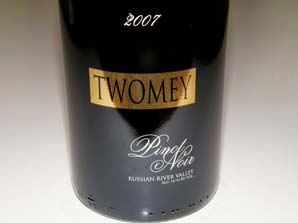 2007 Twomey Cellars Russian River Valley Pinot Noir 14.1% alc., $50. · Moderately light in color. Delicate aromas of Bing cherries, roses, freshsawn oak and baking spices. The cherry core is rich and flavorful enhanced with oak spice and buttressed with ample acidity. Raspberries linger on the long and dry finish. The velvety texture is heavenly. A seamless wine with that signature Pinot Noir ephemeral character.
Twomey offers tasting at both their Calistoga Estate and Healdsburg Estate Monday through Saturday. Tours of the wineries are available by appointment. The wines are sold on the website (www.twomeycellars.com) and through retail channels. 800-505-4850.
Small Sips of More California Pinot2008 Forestville California Pinot Noir 12.5% alc., $3.99 (with a cork and capsule!). Sourced from Northern California vineyards. The first finished 2008 Pinot Noir I have sampled from bottle. Can it be done for $3.99? No way. · Very funky nose highly reduced with aromas of burnt match and burnt banana obscuring all fruit. Cherry and strawberry fruits on the palate that have a roasted or burnt quality. Soft and smooth, moderate tannins and a hint of citrus on the finish. About what you can expect at this price.
2007 D&L Carinalli Vineyards Estate Russian River Valley Pinot Noir 13.6% alc., $16. Domenico Jr. and spouse Linda nurture the vineyard. Aged in French and American oak barrels. · Light garnet color. A simple, clean and delicate wine showing mainly strawberry aromas and flavors. Soft in the mouth and easy to drink. A good value wine to pair with simply prepared salmon or chicken.
2007 DeLoach Vineyards Russian River Valley Pinot Noir 14.5% alc., $18.50. · The nose exhibits aromas of slightly confected black cherries with floral and herbal notes (“field nose”) and noticeable dark oak. Decent fullness on the palate with flavors of strawberries and black cherries with a tang on the mildly persistent dry finish. This will work at the table.
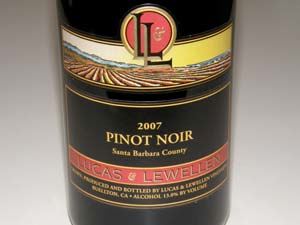 2007 Lucas & Lewellen Santa Barbara County Pinot Noir 13.0% alc., 2,096 cases, $20. Release date is August, 2009. Sourced from the Goodchild and Los Alamos estate vineyards. Several clones. Crafted by winemaker Megan McGrath. Fermentation took place in small, 1.5-ton fermenters. Aged 9 months in neutral French oak. · Very alluring aromas of strawberry jam and subtle oak toast (strawberry jam on toast) which fade a bit over time. An elegant and feminine wine which is soft and smooth with no discernible tannins. The red berry fruit flavors are substantial and pleasing and persist on the finish which is marked by refreshingly brisk acidity. This is an excellent everyday drinker with low alcohol which will perform beautifully at the dinner table. Drink up within the first two years.
2007 Melville Estate Verna’s Sta. Rita Hills Pinot Noir 14.5% alc., $23 (sold out). Clones 2A, 667, 777 and 828. Yields were 1.9 tons per acre. 67% of fruit was de-stemmed and 33% fermented as whole clusters. Total skin and stem contact averaged 30 days. Aged in 18% new French oak. · The nose is similar to the regular Estate bottling with bit more raspberry and strawberry fruit and more persistent barnyard. Demure sweet dark red fruits with hints of tea and minty leaves. Mild dry tannins and brisk acidity on the finish. A simple wine that you don’t need to contemplate to enjoy.
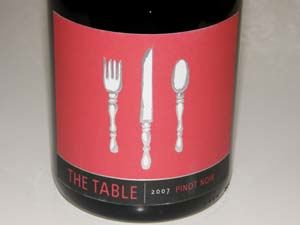 2007 The Table Once Sommelier Series Pinot Noir 14.2% alc., $24. 60% Oregon grapes and 40% California grapes. Cool label. · Herbed dark red fruits on the nose with barnyard in the background. Dark red plum fruit core with some loaminess. Smooth and silky with dusty tannins. A skosh flat and dilute.
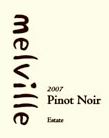 2007 Melville Estate Sta. Rita Hills Pinot Noir 15.3% alc., $32. 14 Pinot Noir clones. Yields were 1.7 tons per acre. 67% of fruit was de-stemmed and 33% fermented as whole clusters. Total skin and stem contact averaged 30 days. Aged in 16% new French oak. · This wine needs some time to open up in the glass. On the nose there are primarily dark red fruits with hints of oak spice and minerals. Tasty red berry fruit accented by tea and pepper drops off on the finish. Medium weighted with mild dry tannins and a good spark of acidity. Holds its alcohol well. The flavors trump the aromas at this stage.
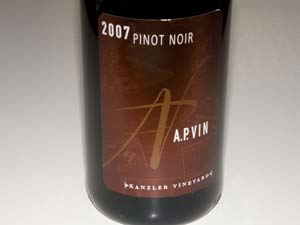 2007 A.P. Vin Kanzler Vineyard Sonoma Coast Pinot Noir 15.2% alc., $39, screw cap. · On the nose there are aromas of black cherries, roasted nuts, toasted oak and a hint of alcohol. A plush bolt of black cherry fruit attacks the palate with some oak in the background. The tannins are powdery and the dry finish is pleasing. Pretty good but not extraordinary.
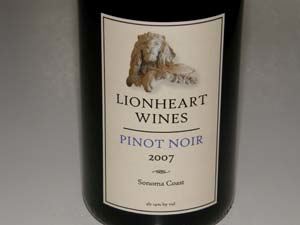 2007 Lionheart Wines Sonoma Coast Pinot Noir 14.61% alc., 48 cases, $40. This is a small boutique winery founded by winemaker Leon C. Glover III whose goal is crafting food-friendly wines. This wine is composed of clones 115, 667, 777 and 828. · The nose displays dusty dark fruit which is a touch candied and nicely accented by herbs. Some alcohol shows up over time in the glass. Moderately rich dark red fruits on the attack with a sidecar of savory herbs. The tannins are powdery and the finish is dry and pleasing. The wine picks up intensity in the glass and grows on you over time.
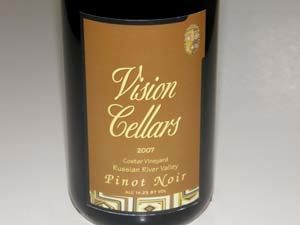 2007 Vision Cellars Coster Vineyard Russian River Valley Pinot Noir 14.2% alc, $45, screw cap. · Rather sensual scents of red cherries, spice and cola. Very tasty cherry and cranberry fruit nicely spiced. Richly flavored but not jammy. Nicely balanced, soft ripe tannins and some persistence on the finish.
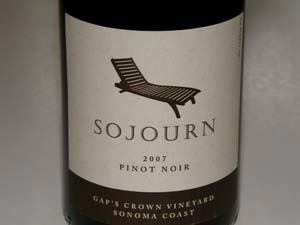 2007 Sojourn Gap’s Crown Vineyard Sonoma Coast Pinot Noir 14.6% alc., $47. This vineyard is located on west-facing slopes of Sonoma Mountain, where the winds and cool fog from the Petaluma Gap are frequently evident. The vineyard is owned and farmed by Premier Pacific Vineyards. Multiple wineries source from this large vineyard of about 140 acres planted to Pinot Noir and Chardonnay. Pinot Noir clones are Swan, 114, 115, 667, 777 and 828 on four different rootstocks. · Really attractive nose composed of bright black cherries, red plums and a dusting of oak. Black cherry and black raspberry fruits cascade easily through the palate complimented by a vein of citric peel and vanillin. Moderately rich with good purity of flavor and a refined mouth feel. A good effort that is very well crafted.
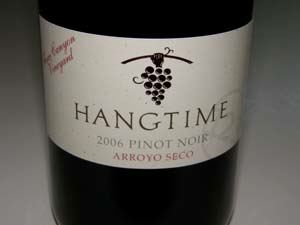 2006 Hangtime Force Canyon Vineyard Arroyo Seco Pinot Noir 13.55 alc., $15. Named for the lengthy hang time (123 days) of the grapes in this wine. · Ripe, jammy berries with hint of new oak on the nose. Thrust of ripe fruit flavors which are slightly raisiny with a touch of tea and mocha dust. Fruity and flavorful, lightly weighted but satisfying. Balanced and clean with admirable finesse. A recession buster.
2006 Cambria Julia’s Vineyard Santa Maria Valley Estate Bottled Pinot Noir 13.9% alc., $20. This well known vineyard is located at the western end of the Cambria Estate on the Santa Maria Bench 17 miles inland from the Pacific Ocean. Named for the owner’s youngest daughter. · Deep red color. Highly nuanced nose of cherries, strawberries, oak, cinnamon and green grass. Light strawberry and cherry flavors with a touch of savory herbs and a grassy finish. Decent acidity and very soft tannins. An easy drinker which will perform well at the dinner table.
2006 Ken Brown Duncan’s Cuvee Santa Rita Hills Pinot Noir 14.5% alc., $25. Sourced primarily from Rio Vista Vineyard with contributions from other local vineyards. · This wine has a strange “diaper” aroma which passes through to the flavors and ruins the experience. There is a decent dark red-fruited core which is moderately sappy. The texture is rich and velvety and the tannins are well managed.
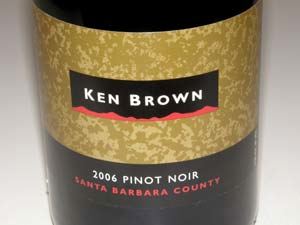 2006 Ken Brown Santa Barbara County Pinot Noir 14.5% alc., $30. Primarily sourced from the Babcock Vineyard in the Santa Rita Hills. · The nose is a bit reserved but pleasant showing scents of black cherries and heavy oak. A fruit-driven wine propelled by dark stone fruits and accents of root beer and toasty oak. Plenty of punch and richness that picks up intensity in the glass. Very drinkable now.
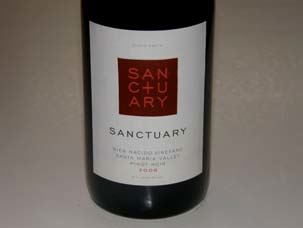 2006 Sanctuary Bien Nacido Vineyard Santa Maria Valley Pinot Noir 14.3% alc., 1,853 cases, $30. Crafted by Fetzer winemaker Dennis Martin who has worked with the Miller family, owners of Bien Nacido Vineyard, since 1985. This is Martin’s private label produced at Fetzer’s winery in Hopland. · Moderately light garnet color. Needs air to open. Earth kissed berries and cherries which are bright and focused augmented by hints of earth, herbs, oak and petrol. Supple tannins make for pleasant drinking. Much better when re-tasted later in the day from a previously opened bottle. I would suggest decanting if you choose to pop a cork now but patience for another year or two will be aptly rewarded.
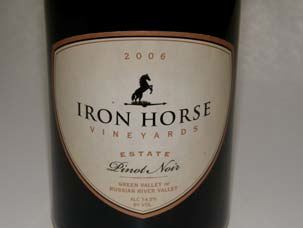 2006 Iron Horse Vineyards Estate Green Valley Pinot Noir 14.5%, $32.50. · Strawberries, cherries and good barnyard attract you to the glass. A melange of lightly weighted red berries and cherries is complimented by flavors of mocha, oak char and mushrooms. This is a wine dominated by high-voltage acidity and marked tannins which compete with the fruit. Not particularly appealing to me, this wine may be attractive to those with a palate attracted by more austere wines over intensely fruity ones.
 2006 Kendric Vineyards Marin County Pinot Noir 13.9% alc., $33. Third vintage from the 8.5-acre Kendric Johnson Vineyard leased to winemaker Stewart Johnson who crafts the wine at Starry Night Winery in Novato. The clones are 115, 828, 667, 777, Pommard and a mystery clone. Kendric Vineyards was established in 2001 and produces 600 cases of Pinot Noir and Syrah. · An intriguing nose that constantly changes in the glass. Many aromas surface including red berries and cherries, root beer, wet leaves and soy. Bright cherry and cranberry fruit is offered in an elegant style with crisp acidity. Some root beer and spice flavors show up. Juicy and fresh, this is a fun drink that I admire for its finesse and its uniqueness. Check out Marin County - the wines will surprise you.
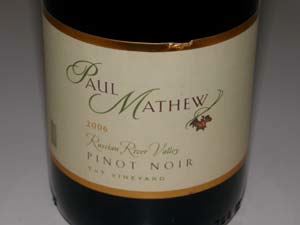 2006 Paul Mathew Vineyards TNT Vineyard Russian River Valley Pinot Noir 14.6% alc., $34. Crafted by owner and winemaker Mat Gustafson. Wild yeast and MLF bacteria. · Ripe aromas and flavors of black cherries and dark red berries, herbed meats and black currants. Tasty with a good acid grip and admirable balance. Would enjoy this wine more if the fruit didn’t veer to far to the ultra ripe side.
2006 Morgan Hat Trick Double L Vineyard Santa Lucia Highlands Pinot Noir 14.0% alc., $45. · Fresh and breezy aromas of plums, grapes and flowers. Darker fruited and medium-weighted with a hint of raisin and a touch of citrus and oak on the finish. Nicely balanced but the fruit doesn’t have much life in the mouth.
2006 Sand Hill Wines Durell Vineyard Sonoma Valley Pinot Noir 13.6% alc., $47. Durell Vineyard is a long time acclaimed producer of Chardonnay for Kistler Vineyards. Durell Vineyard II climate. The vineyard manager is Steve Hill and the winemaker is Don Van Staaveren. 100% de-stemmed, 80% whole berry fermentation, 5 day cold soak, manual punch downs, basket-pressed and gravity-fed into tight grain, medium-plus toast French oak barrels. Aged 14-16 months in barrel and 10-12 months in bottle. · Intense aromas of black cherries, savory herbs and oak. Well-oaked light cherry fruit on the palate with a vegetal edge. Smoothly textured with supple tannins. Tasted twice on different occasions.
2006 Pessagno Four Boys Vineyard Santa Lucia Highlands Pinot Noir 14.6% alc., 208 cases, $50. · Dark reddish-violet color. On the nose the fruit has a cooked profile with notes of raisin, coffee and dark chocolate. Overripe flavors of raisins, even porto, with a sour cherry edge and notable dry tannins. Not for me.
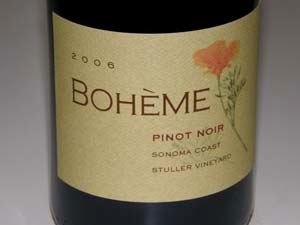 2006 Bohème Stuller Vineyard Sonoma Coast Pinot Noir 15.5% alc., 120 cases, $53. This vineyard is located on a ridge top 6.4 miles from the Pacific Ocean. Aged 17 months in 50% new French oak barrels. · Raspberry, blackberry and current aromas with slightly roasted flavors. Not as over ripe as the Taylor Ridge bottling but still a little raisiny. Huge, succulent core of dark fruits with plenty of tannins. Not a wine for sissies. Tried it with dinner and it was too hot (alcoholic) to compliment the fare. This is a sipping wine, not a table wine.
2006 Bohème Taylor Ridge Vineyard Sonoma Coast Pinot Noir 14.1% alc., 190 cases, $53. This vineyard is located on a bluff 5.3 miles from the Pacific Ocean at 715 feet above sea level. There is notable fog influence in late summer. This wine is sourced from a 2.7-acre plot planted to the Swan selection. Yields were 1.35 tons per acre. Kurt Beitler is the grower and winemaker. · Fragrant super ripe fruit smelling of raisins, soy and roasted nuts. The fruit was picked at an advanced stage of phenolic ripeness and the plush dark fruit tastes of raisins. Good mix of t n’ a. Well-crafted, but disappoints. Only in California!
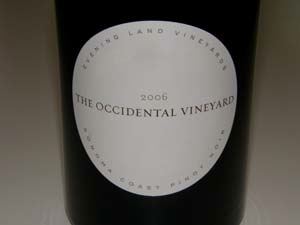 2006 Evening Land Vineyards The Occidental Vineyard Sonoma Coast Pinot Noir 14.9% alc., 120 cases, $150. 3.51 acres, 15 year-old vines, yield 1.28 tons per acre of Calera clone. This wine is crafted by Sashi Moorman in Lompoc. · Very dark reddish-purple color. A shy and brooding nose which starts out with woodsy and barnyard aromas but evolves nicely revealing bright fresh berries, violets and a hint of tobacco. Rich, plush and multilayered on the palate featuring dark stone fruits and flavors of fig and cola framed by a lively edge of acidity. The texture is pillowy and the finish, which has a citrus peel note, lasts and lasts. There still are substantial tannins to shed. Decant if you drink now and pair up with substantial food. This wine will cellar very well.
Anam Cara Cellars: Celtic Pride in Every BottleNick and Sheila Nicholas lovingly nurture a 30-acre vineyard located on the southeastern slopes of the Chehalem Mountains, just north of the town of Newberg. The property was originally an overgrown walnut, plum and hazelnut orchard with a neglected Christmas tree forest and included a quaint farmhouse dating to 1902 and several wooden outhouses. Lying between 450 and 650 feet in elevation, the well drained soils are primarily Jory series. Five blocks of Pinot Noir were planted in 2000-2001 to Pommard, 114, 115, 667 and 777 clones. There is also one acre each of Riesling and Gewürztraminer. Plans call for the planting of 6 more acres to Wädenswil clone Pinot Noir, Chardonnay and more Riesling. Farming is sustainable with both organic and biodynamic practices.
 The words Anam Cara are Celtic for “friend of my soul” and symbolize the journey the Nicholas’s have taken to make their wine and the relationship they have with their vineyard. The label depicts the vineyard. Production is 1,000 cases annually of primarily Pinot Noir with small amounts of Riesling and a Gewürztraminer dessert wine. The winemaker is Aron Hess (Daedalus and several other wineries) and the vineyard managers are Evan Bellinger and Buddy Beck. I have sampled the 2006 lineup of Anam Cara Cellars Pinot Noirs on two occasions and my notes follow. The wines are reflective of the warm 2006 vintage in Oregon which resulted in darker colors, higher alcohols and tremendous concentration of Pinot fruit. These are hearty wines that are beginning to hit their stride now and have enough tannins (beautifully integrated and barely noticeable) and acidity to last a number of years. They will work both as wines for contemplation and wines for drinking at the table. I would recommend decanting if you plan to drink them now.
 2006 Anam Cara Cellars Nicholas Estate Chehalem Mountains Pinot Noir 15.0% alc., $33. · The nose offers demure cherry and raspberry fruit with prominent oak and a touch of good barnyard. Showy dark fruits on the palate with riffs of cola, and showy oak caramel and smoke. Very smooth and harmonious.
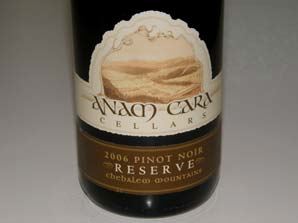 2006 Anam Cara Cellars Nicholas Estate Reserve Chehalem Mountains Pinot Noir 15.0% alc., $45. A few select barrels in the cellar. · The most fragrant wine in the lineup with alluring aromas of red plum, black cherry and dark red raspberries framed by toasty oak. Delicious raspberry fruit core that is full and rich with a touch of anise, tea and oak. A big-boned wine yet it dances smoothly across the palate, leaving a little heat in its wake.
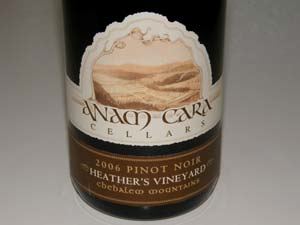 2006 Anam Cara Cellars Heather’s Vineyard Chehalem Mountains Pinot Noir 15.0% alc., 50 cases, $65. This wine is named after the Nicholas’s daughter and is the most feminine wine in the lineup. Sourced from a 5-acre block of Dijon 114. · Aromas of ripe black cherries, herbs and oak char. Smooth and velvety in the mouth with rich but not jammy dark stone fruits and berries, herbs and a deft touch of oak. Clean and juicy with a refreshing acid driven tang on the finish. I like this wine for its elegance.
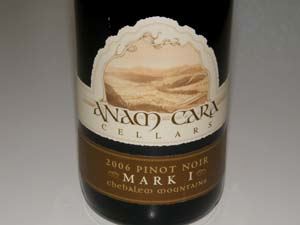 2006 Anam Cara Cellars Mark I Chehalem Mountains Pinot Noir 15.0% alc., 50 cases, $65. This wine is an estate vineyard barrel selection aged in 50% new French oak barrels. Primarily Pommard clone. Named for son, Mark, and is the first vintage of this wine. Intended for the cellar. · Reserved scents of dark cherries and strawberries with a hint of oak. Thick and chewy dark fruits which are at first brooding but pick up life and interest with time in the glass. Nicely composed and balanced. Like a big bear in hibernation who has yet to emerge. Potentially the most magnificent wine in the lineup, but 3-5 years away from maturity.
The Anam Cara Cellars wines are sold through a mailing list and on the website at www.anamcaracellars.com. Tours and tasting are available by appointment. If you visit, check out “Digger,” who roams the property controlling the gopher population.

Arterberry Maresh: Dundee Hills Tradition Carried OnJim Maresh is only twenty-five years old, but is already becoming touted as the “Best Young Oregon Winemaker” (see http://www.avalonwine.com/Arterberry-Maresh-Pinot-noirs-Reviews.html). His father, Jim Arterberry, was a well-known early Oregon Pinot Noir winemaker in the Dundee Hills. In 2007, his son, Jim, revived the Arterberry Cellars label as Arterberry Maresh, releasing his inaugural wines from the 2005 vintage. His 2006 Pinot Noirs were quite impressive and were reviewed in Volume 7, Issue 2. Jim’s mother, Martha Maresh, owns and farms the Maresh Vineyard in the Dundee Hills (pictured below). Maresh Vineyard is the fifth oldest Pinot Noir vineyard in the Willamette Valley. The 2007 vintage Pinot Noirs are lower in alcohol and more lean than their 2006 counterparts. The Maresh Vineyard bottling is always impressive.
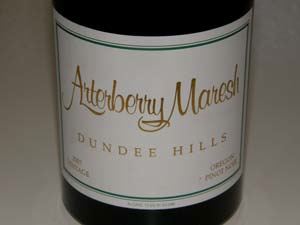 2007 Arterberry Maresh Dundee Hills Oregon Pinot Noir 13.0% alc., $34.95. · Moderately light reddish-in color. The nose is all hay and grass with restrained red fruits. A light and elegant wine featuring demure cranberry and strawberry fruit with a grapefruit peel finish. Rather dilute, but plenty of acidity for refreshing drinking. Close to a rosé and I would drink this wine chilled like a rosé.
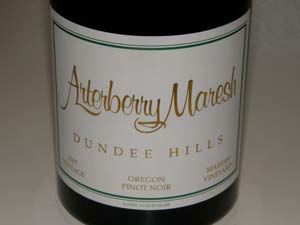 2007 Arterberry Maresh Maresh Vineyard Dundee Hills Oregon Pinot Noir 13.0% alc., $74.95. · A little more color than the appellation bottling. Very heady and penetrating aromas of dark red cherries. Sumptuous red berry and cherry fruits with a sidecar of herbs and a slight green note. Plush, yet elegant with adequate tannins and acidity to support the fruit. Still somewhat reserved and will benefit from another year in bottle.
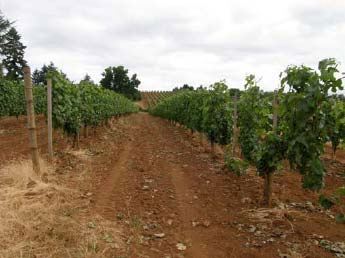 The wines are sold at Avalon Wine, a retailer in Corvallis, Oregon (www.avalonwine.com) and by phone (503-434-7689). The basic website, www.arterberrymaresh.com, offers an e-mail contact for the winemaker.
Evesham Wood: Commendable PinotosityAlison Ruch, Avalon Wines Staff Writer wrote an excellent feature about Evesham Wood wines and winemaker Russell Raney (www.avalonwine.com/Evesham-Wood-Wines.php). Raney’s career in wine began as a winemaker in Germany and subsequently he worked in retail and as a wine buyer for a wholesale company in the United States. He was attracted to Pinot Noir but found few examples in the 1980s worth getting excited about. He decided to craft his own Pinot Noir and began a search for an appropriate setting in North America. He settled on Oregon’s Eola Hills west of Salem and founded his label in 1986. He named his winery Evasham Wood after the Vale of Evesham in the Cotswold Hills of England because the site bore a resemblance to this part of the English countryside. Farming of the 13-acre estate vineyard, named Le Puits Sec (“The Dry Well”), has been organic from the start and the vineyard was certified organic by Oregon Tilth in 2000 (the winery is also certified organic). The vineyard is dry-farmed and Raney is a firm believer in avoiding irrigation of vineyards after the vines are established if the climate is conducive. Ruch notes that Raney said, “But once the vines are into production our feeling is, in addition to wastefulness, the wines that are created from irrigated sites - they may be quite nice wines - are often less distinctive and tend to be very similar from year to year. This is because they’re trying to give the vines, by way of irrigation, the same amounts of water each year.” Raney is a member of the Deep Roots coalition, an advocacy group for wines produced exclusively from non-irrigated vines. Raney has been heavily influenced by Burgundian winemaking techniques and two of his former distant mentors were the famous Henri Jayer of Vosne-Romanee and the less well-known, but equally accomplished, Michelle Niellon. Raney’s admiration for the French is shown in the French names he uses for his wines. Production is kept small (less than 5,000 cases of primarily Pinot Noir and Chardonnay). Raney is committed to elegance and restraint, to balance and expression of terroir, what I refer to as “pinotosity.” Evesham Wood wines are never fruit bombs, even in a warm vintage like 2006. These are connoisseur's wines.
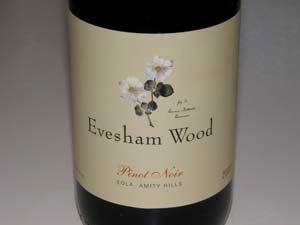 2007 Evesham Wood Eola-Amity Hills Pinot Noir 13.0% alc., 225 cases. $20.95. 65% Hill Vineyard and 35% Bryn Mawr Vineyard which is close by. Aged in 10% new French oak barrels and bottled unfined and unfiltered. · Reserved scents of cherries, peaches, herbs and hay. Light and elegant cherry and strawberry fruit with some structural power due to modest tannins. A thoroughly enjoyable value-priced Pinot Noir that gets the job done.
 2007 Evesham Wood La Grive Bleue Eola-Amity Hills Pinot Noir 13.0% alc., 300 cases, $24.95. Made from the Evesham Wood estate vineyard which is a younger (12-year-old vines) part of the vineyard planted to clones 114 and 777. Ripest fruit on the estate in 2007. Aged 15 months in 15% new French oak barrels and bottled without fining or filtration. · The fruit comes in waves on the nose. Medium weighted red Pinot fruits on the palate with a little citrus note and subtle oak riff on the back end. Tasty and smoothly textured. A little more oomph and character than the regular Eola-Amity Hills bottling.
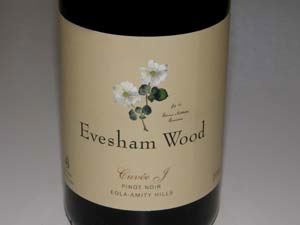 2006 Evesham Wood Cuvée J Eola-Amity Hills Pinot Noir 13.0% alc., 171 cases, $44.95. This is Raney’s top Pinot Noir created for cellaring. Sourced exclusively from the estate vineyard, Le Puits Sec, with the fruit from the older Pommard section of the vineyard. Aged in 50% new French oak barrels and bottled without fining or filtration. · Riper and darker fruit highlighted with flavors of root beer, cola, marzipan and tea. This wine has a glass-filling presence yet retains an admirable elegance. The mouth feel is refined and the finish is remarkably persistent. The balance is spot on portending a long life ahead. Impressive effort.
Evesham Wood Vineyards and Winery is located at 3795 Wallace Rd NW in Salem. The above wines are available from Avalon Wine in Oregon (www.avalonwine.com). Visitors are welcome for tours and tasting by appointment. 503-371-8478. Open houses are held on Memorial Day weekend and the weekend before Thanksgiving each year.
Scott Paul Wines: Fine Oregon Pinot Noir and Burgundy too!Proprietor and winemaker Scott Paul Wright had a thirty-year career in the music business. A well-known radio disc jockey (“Shadow Stevens”), he later worked in marketing and promotion for the radio and record industries. His successful career allowed him to enjoy the pleasures of famous wines. Eventually disenchanted with the music business, he left to become a winemaker. He would become the Managing Director of Domaine Drouhin and later started his own winery in Carlton, Scott Paul Wines. Scott Paul Wines is a boutique winery dedicated to producing ultra-premium Oregon Pinot Noir. Scott’s co-winemaker, Kelley Fox, has years of experience at Eyrie Vineyards, Hamacher Wines and Torii Mor. Scott’s spouse, Martha, is the Brand Manager for Scott Paul Wines.
 Scott is a Burgundy aficionado and imports Burgundies under the name, Scott Paul Selections. In addition, Scott will be producing a Scott Paul wine in Burgundy. The first wine is a 2008 Chambolle-Musigny Les Bussieres and will be released in 2010. Scott is a confirmed Chambolle freak. Who isn’t? Scott’s wines are crafted in the Burgundian tradition with low yields in the vineyard and hands-off vinification in the winery which has no pumps. The winemaking employs no inoculations, no enzymes, no additives, no fining and no filtering. (What exactly does Kelley and Scott do all day?). Small amounts of new French oak are used (20% at most). Each vintage there are three cuvées sourced from several of Oregon’s finest vineyards including Maresh, Momtazi, Shea, Ribbon Ridge and Stoller. The three wines are Le Paulée, Cuvée Martha Pirrie and Audrey. The Audrey bottling recently has been sourced only from Maresh Vineyard. Like many of the Oregon Pinot Noirs from the 2007 vintage, the Scott Paul Wines are gentle, reserved and subtle. Given enough attention, they will charm you.
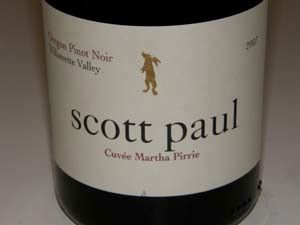 2007 Scott Paul Cuvée Martha Pirrie Willamette Valley Pinot Noir 13.1% alc., $25, screw cap. A selection from five sub-appellations of the Willamette Valley. Named after the Wrights’ daughter. · A light and delicate wine with pleasing aromas and flavors of red berries, spice and herbs. Simple and easy to drink, I like it for its finesse.
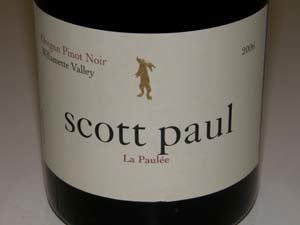 2007 Scott Paul La Paulée Willamette Valley Pinot Noir 13.9% alc., $30, screw cap. Made from the finest lots of the vintage from Ribbon Ridge, Momtazi, Shea and Stoller Vineyards. · Darkest in color of the three 2007 wines. Very lovely nose that is deep and satisfying, featuring ripe strawberries, red plums, cherries and savory Asian spice. Tasty and focused dark red fruits with a hint of earthiness and oak. The mouth feel is silky and the whole package is very harmonious.
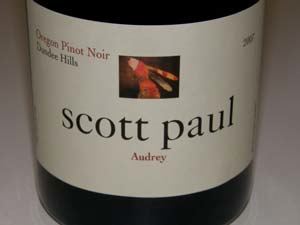 2007 Scott Paul Audrey Dundee Hills Willamette Valley Pinot Noir 13.1% alc., $65, screw cap. A barrel of the finest, most elegant and silkiest wine of the vintage. Sourced from blocks of Maresh Vineyard in the Dundee Hills planted in 1970. The name of this wine comes from Audrey Hepburn and is crafted to reflect her stylish grace and elegance. Also available in magnums. · This is not a “reserve” wine that is pumped up with fruit and oak. Restrained but very alluring perfume of crushed red berries, Provencal herbs, Chinese five-spice and gentle oak. Light, feminine and very satiny, yet delivers plenty of vibrant fruit flavor. The tannins are gossamer and the pleasing finish hints of fresh herbs and oak. The pedigree of the vineyard shows through and this is the most sophisticated wine of the Scott Paul trio.
The Scott Paul Wines tasting room is housed in a restored circa-1915 creamery and is the only one I know of in the United States that offers the visitor both New World and Old World Pinot Noir side by side. The Tasting Room is open daily from 11:00 to 4:00 Wednesdays through Sundays. Guided tastings are also available by appointment (contact Kelly Karr at 503-319-5827). The website is www.scottpaul.com. Listen to my interview with Scott Wright on Grape Radio: http://www.graperadio.com/archives/2008/03/31/shadow-stevens-and-thewines- of-scott-paul/. The Burgundy Express Wine Club offers two shipments each year of Scott Paul Selections Burgundies. Each shipment is intended as an educational and informative tasting flight with a specific topic covered in each group of four to six wines.
Small Sips of More Oregon Pinot
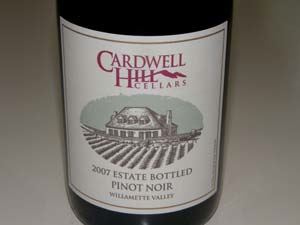 2007 Cardwell Hill Cellars Estate Bottled Willamette Valley Pinot Noir 13.2% alc., $25. Made from original plantings of Wädenswil (1985) and more recently planted Pommard, 115 and 777. The estate vineyard is dry farmed and lovingly nurtured by Dan and Nancy Chapel. · Dark-fruited, brambly, herbal nose with hints of Moroccan spice and roasted nuts. Dark and brooding, with rich, showy and mouth filling dark red cherries and raspberries leading to a dry finish. Impressive extraction and ripeness for the 2007 vintage. Still has some tannins to shed and will benefit from another 6 months in bottle. A great value.
Note: Cardwell Hill Cellars is located in Philomath, just west of Corvallis. The Chapels poured their 2006 vintage, now sold out, at last year’s International Pinot Noir Celebration. The Chapels also happen to be my neighbors and live a block away. They split their time between Orange County and Philomath, not an easy task. Read more from a previous issue (www.princeofpinot.com/article/176/).
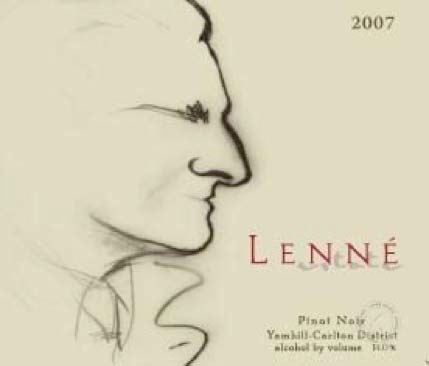 2007 Lenné Estate Karen’s Pommard Yamhill-Carlton District Willamette Valley Pinot Noir 14.0% alc., 73 cases, $55. · The aromas recall an exotic perfume exhibiting wild dark red fruits and spring bouquet. The wine is powerfully flavored yet retains the delicacy and velvety texture that is so sensual in Pinot Noir. Multilayered flavors of red plums, ripe berries, currants, spice and a little earthiness. Perfect integration of t n‘ a. There is something magical about this vineyard.
Note: Lenné Estate was reviewed in Volume 7, Issue 15 (www.princeofpinot.com/article/648/). The wines are sold through a mailing list and on the website at www.leneeestate.com. The 2007 lineup of Pinot Noirs were very impressive.
Station Imports: Central Otago Schist-Kissed Pinot NoirMany people have an image in their mind of snow when they think of New Zealand’s South Island and it would seem that the climate is not conducive to growing Pinot Noir. The truth is that Central Otago, which sits in the most southerly part of New Zealand’s South Island, lies at the same latitude as Burgundy (45 degrees) but in the Southern Hemisphere. In an otherwise maritime country, Central Otago surprisingly has a continental climate because of its location surrounded by mountains which shield the region from ocean influences. Central Otago is the driest part of the country. The landscape has been created by volcanos and shaped and carved by glaciers creating deep beds of loess, schist (a metamorphic rock type that has a schistose fabric - coarse mineral grains which split into thin layers), quartz and greywacke (a hard, darkly colored sandstone) that provide the vineyards of Central Otago with good minerality and low organic matter that compare to the bare bone soils of Burgundy. Station Imports is owned by Penny and Andy Loving (pictured below) who import wines to the United States from the Central Otago Wine Company and Rippon Vineyard as well as select producers in Marlborough. You have probably seen them in recent years pouring their wines at events like the World of Pinot Noir. The winemaker at Central Otago Wine Company, Dean Shaw, is often in toe as well and he is quite a character with a droll sense of humor and a serious passion for Pinot Noir. Shaw has a postgraduate degree in Viticulture and Wine Science from Lincoln University in Canterbury, New Zealand. He first came to Central Otago to work at Rippon Vineyard in 1994-1995. Later he settled in Cromwell as a partner in the Central Otago Wine Company that provides contract winemaking facilities for many local producers. It might be the impressive stereo system that he serenades his wines with or the minimal intervention or the use of wild yeasts, that gives his wines the many accolades from the wine press.
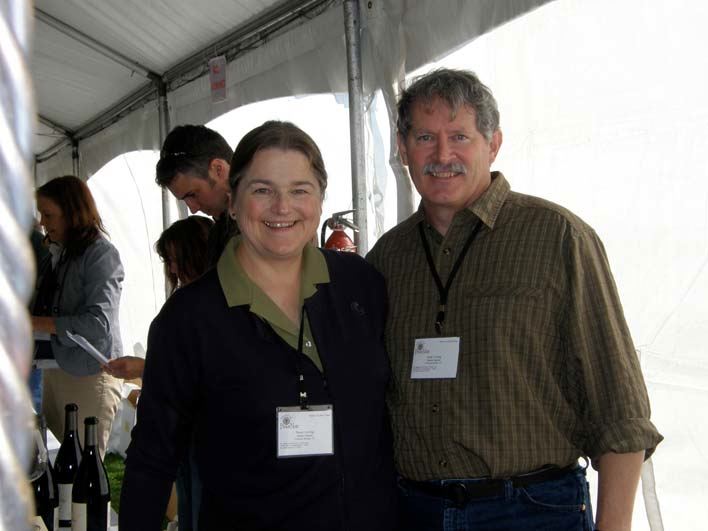 The Pinot Noirs from Station Imports are reasonably priced and offer a sensible opportunity to satisfy your curiosity about the Pinot Noir from down under. The 2007 vintage in Central Otago was quite successful as Joshua Greene proclaimed in the February, 2009 issue of Wine & Spirits magazine. “The 2007s will likely mark a turning point for the Central Otago region, with a critical mass of great Pinot Noir grown in schist.”
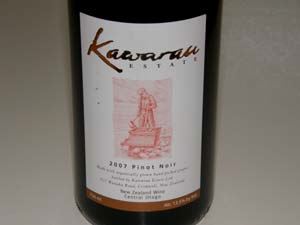 2007 Kawarau Estate Central Otago Pinot Noir 13.5% alc., $19.80, screw cap. Made from an organically-farmed vineyard located on the Pisa Flats of Cromwell. Certified organic by Biogrow NZ. Imported by Station Imports LLC, Colorado Springs, Colorado. · Restrained fruit with prominent oak char on the nose. Red plum and berry flavors with a vein of oak and citrus running through. A simple, fruit-driven wine that will appeal to oak lovers.
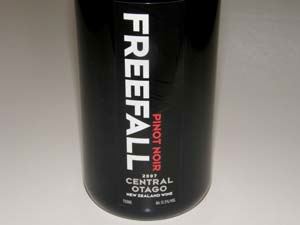 2007 Freefall Central Otago Pinot Noir 13.5% alc., $23.25. Cool package. Imported by Station Imports LLC, Colorado Springs, Colorado. · Deep reddishviolet color. Funky reduction initially blows off. An earthy nose that smells of the soil and is heavily perfumed with blackberry and black plum fruit. Substantial dark fruits with a dusting of dark chocolate and oak spice framed by plentiful acidity. A very smooth mouthfeel makes for easy drinking.
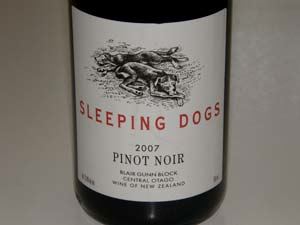 2007 Sleeping Dogs Blair Gum Block Central Otago Pinot Noir 13.0% alc., $26.75, screw cap. From a vineyard on Old Gibbston Rd. farmed by owner Roger Donaldson and managed by viticulturist Richard Williams. Imported by Station Imports LLC, Colorado Springs, Colorado. · Very showy and persistent aromas of dark berries and black cherries with a hint of Moroccan spice. Terrific nose. Drinks like a berry smoothie with some herbs added in for health. Gossamer tannins, pillowy texture and racy acidity. A delightful drink with plenty of zip and zing.
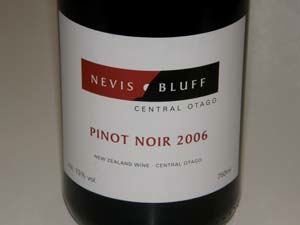 2006 Nevis Bluff Central Otago Pinot Noir 13.0% alc., $26.50, screw cap. Sourced from vines planted in1993 in Gibbston and vineyards nearby. Imported by Station Imports LLC, Colorado Springs, Colorado. · Dried herbs and daisies on the nose followed in the mouth by rich, mouth filling strawberries, raspberries and cherries. The finish has good cut. A well-crafted, decent wine that is a bit bland but represents reasonably good value.
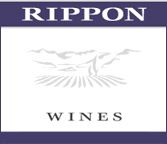 2006 Rippon Lake Wanaka Central Otago Pinot Noir 13.0% alc., $50, Diam closure. From a biodynamically-farmed vineyard. The proprietor and winemaker is Nick Mills. Aged 16 months in French oak barrels. Unfined and unfiltered. · I have nothing but superlatives for this wine which is filled with grace and vibrancy. Lovely strawberry and cherry fruit with a hint of spice supported by fine-grain tannins and crisp acidity. Elegant and refined with a smooth and velvety texture. Very Chambollesque. At 13% alcohol you can drink this comfortably with a good meal. The best Pinot Noir yet from Rippon.
All the wines above are available through Station Imports on the website at www.stationimports.com. Discounts are offered for multiple-bottle buys. If you are traveling to Central Otago, ask the Lovings to set up appointments for you to visit the Central Otago Wine Company and Rippon Vineyard.
More Sips of Pinot from Down Under 2004 Pipers Brook Vineyard Reserve Tasmania Pinot Noir 13.6% alc., $40. Made from the best parcels from the best vineyards. Macerated on the skins for up to 25 days, aged 14 months in French oak barrels. Winemaker is René Bezemer. Imported by American Estate Wines Inc., Philadelphia, PA. · This wine has a paucity of fruit in the aromas and flavors showing instead dried herbs, brown spice, coffee and toast. Flamboyant tannins and bright acidity overwhelm the demure and faded fruit. Might drink better with food.
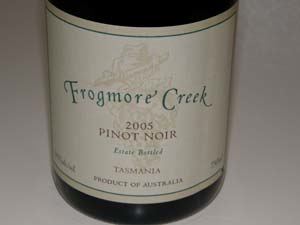 2005 Frogmore Creek Estate Bottled Tasmania Pinot Noir 14.1% alc., $25. Winemaker is Andrew Hood. Imported by Hathaway Trading Co., Inc., Ladera Ranch, CA. · Moderately light garnet color. Lovely aromas of spiced red fruits with savory herbs. Very Pinot. Lightly weighted, even a bit dilute, with notes of herbs, white pepper and grapefruit accenting the delicate red fruits. Supple tannins, easy and approachable.
 2005 42º S (Forty-Two Degrees South) Tasmania Pinot Noir 12.6% alc., $16. Part of the Hood Wines portfolio. Imported by Hathaway Trading Co., Inc., Ladera Ranch, CA. · The aromas are not terribly appealing featuring pungent herbs, coffee, roasted nuts and a whiff of alcohol. Ripe fruit tending toward raisin and root beer flavors. Very smoothly textured with soft tannins and a tangy finish. The flavors trump the aromas but nothing special here.
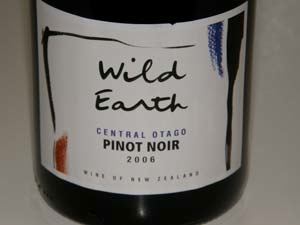 2006 Wild Earth Central Otago Pinot Noir 14.0% alc., $24, screw cap. Labels feature original art by New Zealand artists. Vineyards are located on Felton Road overlooking Lake Dunstan. Pommard and Dijon clones. Imported by San Francisco Wine Exchange, San Francisco, CA. · Ripe fruit profile on the nose showing black cherries, raisins, forest floor and a touch of cigar box. Tasty cherry and raspberry core with a hint of orange peel and oak. Notable tannins and bright acidity. Decent.
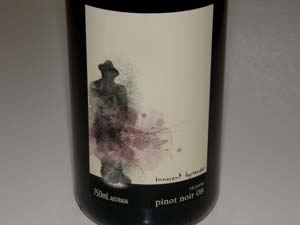 2008 Innocent Bystander Victoria Australia Pinot Noir 14.1% alc., $16. Sourced from 8 cool-climate vineyards. Imported by Old Bridge Cellars, Napa, CA. · Lightly colored with reddish highlights. The nose is dominated by herbaceous oak with little fruit. Light raspberry and cherry fruit on the palate with a riff of oak evident from entry to finish. Velvety with supple tannins in a feminine style. This wine is an easy quaff.
Penfolds, founded in 1844, and now part of the huge Foster’s Group, produces over 2 million cases of wine annually. In the mid 1990s, they quietly began developing a line of “boutique” wines crafted by winemaker Peter Gago and his team. Penfolds has made its reputation on Cabernet Sauvignon and Shiraz, either singly or in blends, but the new Cellar Reserve label features varietals like Pinot Noir, Sangiovese, Grenache, Tempranillo and Sauvignon Blanc. The first commercial release was the 1997 Adelaide Hills Pinot Noir. The Cellar Reserve wines are made in tiny quantities by hand at Penfold’s Magill Estate winery in Adelaide. Penfold’s flagship wines, Grange and Bin 707, are also made in small quantities, so Penfold’s may qualify as the world’s largest boutique winery.
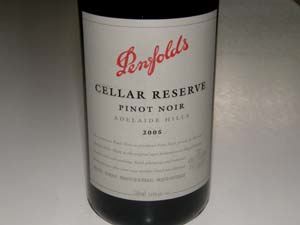 2005 Penfolds Cellar Reserve Adelaide Hills Pinot Noir 14.0% alc., $35. After a cold soak, the grapes are fermented in open-top fermenters driven by natural yeast with the use of hand punch downs. Unfined and unfiltered. · This wine is quite different from what we have come to expect from Pinot Noir crafted in North America. I found it difficult to describe the components of the aromatic profile but did identify raisins and a hint of porto. Dark fruits, sassafras, root vegetables on the palate. Looks and tastes slightly brown. There is some appealing textural softness and stylistic finesse. Tastes of Pinot Noir grown in California in the early 1980s on sites that were too warm. Only for the curious.
Recently Released Wine Books
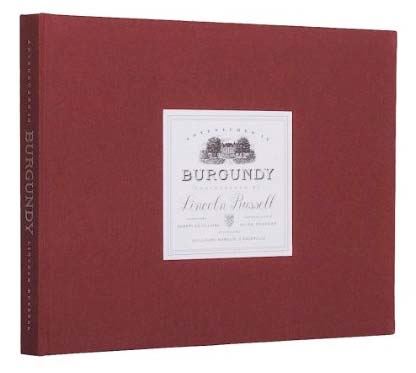
Adventures in BurgundyThis book is a result of a serendipitous meeting between the author, Lincoln Russell, and Burgundian winemaker, Etienne de Montille, while skiing the French Alps in January, 2005. Montille suggest to Russell that he do a book on harvest although Russell had never set foot in Burgundy. Russell was a Francophile at heart and he had twenty-five years of experience in photography, so off he went to Burgundy, spending large blocks of time there for three years. He was taken in warmly by the tight-knit community of Burgundians and allowed special access for many of his photographs. Although the name would suggest a book filled with prose about wine travels, Adventures in Burgundy is a photographic impression of Burgundy, representing a selection of photos out of tens of thousands Russell took over a three year period. The beautiful pictures speak a language of their own conveying the spirit of the people and the land that together produce the world’s most glorious wines. The magnificent portrait-quality photographs capture the face of famous vignerons such as Jacques Seysses, Charles Rousseau, Christophe Roumier, and Patrick Bize. Some of the photographs sent chills down my spine, causing me to dream of Burgundies I have enjoyed in the past: the head of a Francois Freres barrel imprinted with the words, “Romanee-Conti,” unlabeled dusty bottles with tags reading 1845 Clos Vougeot, the 17th century cellar at Chateau de Chamirey, the wine cellar at Restaurant Tallevent in Paris, and harvest at La Tache. I have traveled to Burgundy and returned with many personal photographs that bring back fond memories, but I will always cherish this book for it captures Burgundy like I could never do. You cannot have enough photographs of Burgundy if you are captivated by the history, the landscape, the tradition, the impassioned folks who craft fine Burgundy, and, of course, the wines. As Allen Meadows wrote in the Introduction for this book referencing a great Burgundy wine, “I have seen grown men cry, and, on more than one occasion, seen entire dinner parties struck silent by the unmatched genius of a magic bottle.” The large book is packaged in an appropriate Burgundy-colored cover with a tastefully simple label. Included are a Forward by Aubert de Villaine of Domaine Romanee-Conti, an Introduction by noted Burgundy expert Allen Meadows, and an Afterword by respected vigneron Guillaume Marquis D’Angerville. Published by Pinot Press/Stockbridge, hard bound, 168 pages, 2008, $50. If you want to honor a good friend or spoil a spouse, give them this book along with a great bottle of Burgundy.
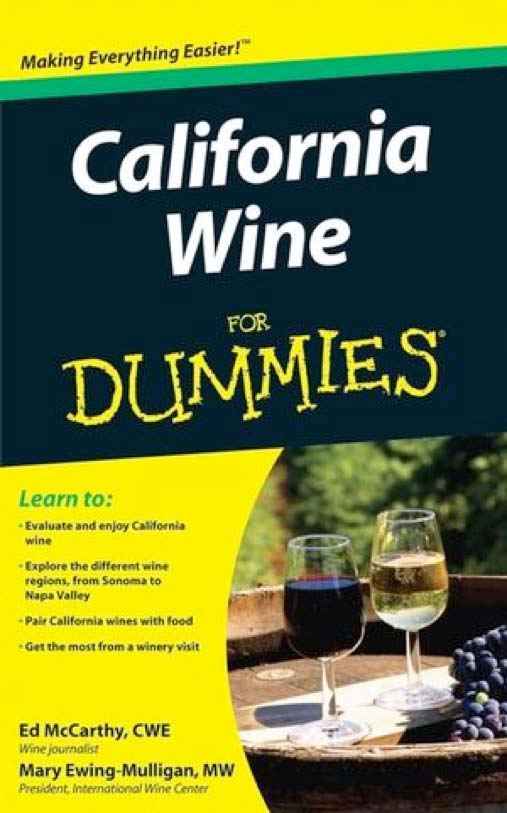
California Wine for DummiesThis is the seventh book Ed McCarthy, CWE, and Mary Ewing-Mulligan, MW, have written for the Dummies series of books written for beginners. The pair are married, having met at an Italian wine tasting many years ago in New York. McCarthy is a noted wine journalist and Ewing-Mulligan is a Master of Wine and together they have more than a half century of wine experience between them. Their original title for the Dummies series, Wine for Dummies, covers the very basics. Consider this book a sequel that focuses only on California wine. The introductory chapters (“The Big Picture”) cover the major varieties of grapes grown in California and a short history of the major wine-producing regions. There is a comprehensive listing of appellations but it would have been helpful to include appellation websites as they are excellent sources of region-specific information. Explanations of confusing wine terminology are included such as the words variety and varietal, and unregulated terms like estate grown, estate bottled and reserve. Curiously, the section on decoding a label has no illustration of a label for reference and doesn’t explain that the alcohol percentage may be on the front or back label of a bottle. The major varieties of California wine are featured in “The Headliners” chapters including Chardonnay, Sauvignon Blanc, Cabernet Sauvignon, Merlot, Pinot Noir and Zinfandel. Less common varieties such as sparkling wines, rosés and dessert wines are also included. Recommended wines are categorized according to three price categories, $12-$20, $20-$50, and $50-$100. The lists of wines are very comprehensive. Sprinkled throughout the text are pearls such as, “When in doubt, reach for a Cab since they are more consistent in quality,” Embrace etiquette of tasting and spitting,” “There is plenty of wine at whatever price you choose,” and “Your personal taste, not what other people tell you, must dictate your final choice of wine.” The chapter on visiting tasting rooms and staying reasonably sober including the etiquette of spitting contains invaluable advice. This book should be required reading for millenials, who are currently embracing wine drinking in this country. The young generation will take to the book because it is a quick read that is well organized. “Technical stuff” icons provide detailed information on certain topics but can be skipped or revisited. The reader can pick up at any point in the book and use it as a quick reference. Its handy size make it easy to pack for wine country trips. The book is also available in a smaller pocket edition for even more portability. California Wine for Dummies is published by Wiley Publishing, Hoboken, N.J., paperback, 269 pages, 2009, $16.99.

The Vineyard CookbookBarbara Scott-Goodman has compiled three menus for each of the four seasons (12 multi-course menus) comprising 60 recipes inspired by our country’s wineries. Along with the recipes, there are brief profiles on wine varieties, wine recommendations offering different options arrange by price (four to nine options per course), and simple vignettes of 32 wineries from California, Oregon, Washington, Virginia and New York. The most redeeming feature of this book is that the recipes are SIMPLE! I would not call this a gourmand’s collection of recipes but that’s not the idea. It is a utilitarian book that even a kitchen klutz like myself can use to turn out great dishes. Most of the recipes have only 7 to 8 ingredients and the instructions are clearly stated in three steps in many cases. These are dependable recipes without exotic ingredients that anyone can be prepared in a reasonably short period. Examples are grilled tuna with mango salsa, pork loin with orange marmalade glaze and slow-roasted cherry tomatoes. Complimenting the recipes are 100 food, vineyard and winery scenes beautifully photographed. There is a helpful section included on hosting a wine and cheese party with descriptions of the major types of cheeses and appropriate wine pairings. The book has an excellent index of recipes and the recommended wines are indexed by producer. The emphasis of the book on seasonality is commendable as Americans have come to realize the value of dining on foods that are fresh and local. This is a very useful cook book for SIMPLE to prepare satisfying meals and appropriate wine pairings. Searching for the recommended wines should not be daunting. Simply consult your nearby fine wine retailer or search on the internet using wine-searcher.com, vinquire.com or winezap.com. The Vineyard Cookbook is published by Welcome Books, New York, hard bound, 160 pages, 2009, $24.95.
Prince of Pinot Impostor!My friend, Dale Bartley, a home winemaker of little repute with a fondness for Zinfandel (Zin from Dale), was traveling to Middle Earth recently and found a Prince of Pinot impostor at Rockburn Winery in Central Otago. Malcolm Francis, Rockburn’s award-wining winemaker, had a copy of a publication to prove his provenance. I was aware of only one other impostor, Larry McKenna, of Escarpment Winery in Martinborough. Don’t be fooled by these tricksters. There is only one true Prince of Pinot.
 |